Green Your Tech: Smartphone Recycling Guide
Did you know that over 152 million smartphones are discarded every year in the United States alone? That’s enough electronic waste to fill 55 Olympic-sized swimming pools! The rapid pace of technological advancements has led to a staggering amount of smartphone waste, posing significant environmental challenges.
In this comprehensive guide, we will explore the importance of smartphone recycling and provide you with essential information on how to properly dispose of your old devices. By adopting eco-friendly practices, you can reduce e-waste, minimize the carbon footprint of smartphone manufacturing and disposal, and contribute to resource conservation.
Key Takeaways:
- Smartphone recycling plays a crucial role in reducing electronic waste.
- Proper smartphone disposal helps minimize the carbon footprint of manufacturing and disposal.
- Recycling provides an opportunity to conserve valuable resources.
- By choosing responsible recyclers, you can ensure your data security.
- Implementing best practices for smartphone recycling contributes to a more sustainable tech ecosystem.
The Environmental Impact of Smartphones
In this section, we will delve into the environmental impact of smartphones. We will discuss the effects of e-waste on the environment and the need for proper smartphone recycling. Additionally, we will explore the carbon footprint associated with the manufacturing and disposal of smartphones, as well as the depletion of valuable resources. Understanding these factors is crucial for making informed decisions about smartphone disposal.
Understanding E-Waste and Smartphones
E-waste refers to electronic waste, which includes discarded electronic devices such as smartphones. The rapid advancement of technology and the high turnover rate of smartphones contribute to the growing e-waste problem worldwide. When smartphones are improperly disposed of, they contribute to landfills, releasing hazardous substances into the environment. These substances can pollute soil and water, harming both human health and ecosystems.
The Carbon Footprint of Manufacturing and Disposal
The manufacturing and disposal of smartphones generate a significant carbon footprint. The production process involves extracting raw materials, manufacturing components, assembling devices, and transporting them to market. Each step contributes to greenhouse gas emissions, particularly carbon dioxide, which contributes to climate change. Additionally, the improper disposal of smartphones leads to the release of harmful emissions during incineration or decomposition in landfills.
Resource Depletion: Why Recycling Matters
The manufacturing of smartphones requires the extraction of finite resources like rare earth metals, minerals, and energy-intensive materials. These resources are not only limited in supply but also contribute to environmental degradation and ecosystem disruption during extraction. By recycling smartphones, we can recover valuable materials and reduce the need for further resource extraction, promoting sustainability and conservation.
Smartphone Lifecycle: From Creation to Waste

In this section, we will explore the entire lifecycle of a smartphone, from its creation to its eventual disposal. Understanding the various stages of the smartphone lifecycle is crucial for comprehending the environmental impact of these devices and identifying opportunities for sustainable practices.
The lifecycle of a smartphone can be divided into four main stages:
- Manufacturing: This stage involves sourcing raw materials, assembling components, and manufacturing the smartphone. It requires significant energy consumption, water usage, and the extraction of precious metals and minerals.
- Distribution: After production, smartphones are distributed to retailers and consumers worldwide. This stage involves packaging, transportation, and logistics, contributing to carbon emissions and waste generation.
- Use: During this stage, consumers utilize their smartphones for communication, entertainment, and various other purposes. Although the use phase does not directly contribute to electronic waste (e-waste), it impacts energy consumption and carbon emissions through charging, data usage, and device maintenance.
- End-of-life: Once a smartphone reaches the end of its usable life, it becomes electronic waste. Improper disposal of e-waste can have detrimental effects on the environment and human health. It is essential to recycle smartphones to recover valuable resources and minimize the negative impact on our planet.
By understanding the complete product lifecycle, we gain insight into the challenges and opportunities for sustainable practices in each stage. From implementing eco-friendly manufacturing processes to encouraging responsible consumer behavior, every step counts in mitigating the environmental impact of smartphones.
Preparing Your Smartphone for Recycling
This section will guide you through the necessary steps to prepare your smartphone for recycling. It is essential to take these precautions to ensure the proper handling of your device and protect your personal information.
Data Backup and Factory Reset
Before recycling your smartphone, it is crucial to back up your data to prevent any loss of valuable information. You can back up your photos, videos, contacts, and other important files by connecting your device to a computer or using cloud storage services. Once you have completed the backup, perform a factory reset to erase all the data and settings on your smartphone. This step will help protect your privacy and ensure that no personal information remains on the device.
Removing SIM and SD Cards
Prior to recycling your smartphone, remove the SIM card and SD card from the device. The SIM card contains personal information, such as contacts and text messages, while the SD card stores files and media. Safely eject these cards and keep them for potential use in your new device or secure disposal.
Assessing Your Smartphone’s Condition
Before recycling, it is essential to assess the condition of your smartphone. Check for any physical damage, such as cracks, dents, or water damage. Determine if the device is still functional or if it has any performance issues. This assessment will help determine the appropriate recycling options for your smartphone, whether it can be refurbished or if it needs to be recycled for its components.
Smartphone Recycling Options and How They Work

When it comes to smartphone recycling, there are several options available to consumers. By choosing the right recycling method, you can ensure that your old devices are disposed of responsibly, minimizing their impact on the environment. In this section, we will explore the different smartphone recycling options and how they work.
Local Collection Points and E-Waste Centers
One option for recycling your smartphone is to take it to a local collection point or e-waste center. These facilities are specifically designed to handle electronic waste, including smartphones. They have the infrastructure and expertise to properly recycle and dispose of your device in an environmentally friendly manner. By using local collection points and e-waste centers, you can conveniently drop off your old smartphone and ensure that it is recycled responsibly.
Mail-in Recycling Programs
If you are unable to access a local collection point or e-waste center, another option is to participate in mail-in recycling programs. Many organizations and companies offer mail-in recycling services, allowing you to ship your old smartphone to a designated recycling facility. These programs often provide pre-paid shipping labels, making the process easy and accessible. By choosing a reputable mail-in recycling program, you can contribute to the recycling efforts and reduce e-waste, even if you don’t have a local collection point nearby.
Retailer Take-Back Initiatives
Several retailers have implemented take-back initiatives to encourage smartphone recycling. These initiatives allow customers to return their old devices to the retailer for proper disposal. Retailers often partner with certified e-waste recyclers to ensure that the smartphones are recycled in an environmentally responsible manner. By participating in retailer take-back initiatives, you can conveniently recycle your smartphone while taking advantage of the infrastructure already in place at the retailer.
To summarize, consumers have multiple options for recycling their smartphones. Whether utilizing local collection points, participating in mail-in recycling programs, or taking advantage of retailer take-back initiatives, the aim is to ensure proper disposal and reduce e-waste. Choosing a recycling option that aligns with your needs and location will enable you to contribute to a more sustainable tech ecosystem, minimizing the impact on the environment.
Understanding the Smartphone Recycling Process
In this section, we will provide an in-depth understanding of the smartphone recycling process. It is essential to comprehend how smartphones are recycled to evaluate the effectiveness of recycling efforts and the environmental benefits they bring.
Smartphone recycling begins with collection. Various methods, such as drop-off points, e-waste centers, and mail-in programs, facilitate the collection of old smartphones. These collection points play a vital role in ensuring proper disposal and preventing these devices from ending up in landfills or being improperly recycled.
Once collected, the smartphones undergo a meticulous recycling process. They are first sorted to identify the different materials present, such as metals, plastics, and glass. The separation of these components allows for efficient recycling and recovery of valuable resources.
Next, the smartphones are disassembled, and the various parts and components are further separated and processed. This step helps to extract valuable metals like gold, silver, and copper, which can be reused in the manufacturing of new devices.
After the valuable materials have been recovered, the remaining components are further treated for safe disposal or recycling. This includes properly handling hazardous substances and ensuring compliance with environmental regulations.
Finally, the recycled materials are sent to specialized recycling facilities. These facilities use advanced technologies to process the recovered materials and transform them into reusable raw materials. The recycled materials can then be used in the manufacturing of new products, reducing the need for extracting new resources.
The smartphone recycling process provides numerous environmental benefits. It reduces the demand for raw materials, conserves energy, minimizes greenhouse gas emissions, and prevents the accumulation of electronic waste. By participating in smartphone recycling, individuals can contribute to a more sustainable and circular economy.
How to Choose a Responsible Smartphone Recycler

When it comes to smartphone recycling, it’s important to choose a responsible recycler that prioritizes proper handling and disposal of electronic waste. By selecting certified e-waste recyclers, you can ensure that your old devices are recycled in an environmentally-friendly manner. In this section, we will guide you through the process of choosing a responsible smartphone recycler. We will also highlight the significance of data security in the recycling process.
Identifying Certified E-Waste Recyclers
One of the key factors to consider when selecting a smartphone recycler is their certification as an e-waste recycling facility. Look for recyclers that have obtained certifications from recognized organizations, such as the e-Stewards and R2 Responsible Recycling standards. These certifications require recyclers to adhere to strict environmental and ethical standards in the handling and disposal of electronic waste.
Key Questions to Ask Before Recycling
Before handing over your smartphone to a recycler, it’s important to ask a few key questions to ensure that they are committed to responsible recycling practices. Some questions to consider asking include:
- Do you have any certifications from recognized e-waste recycling standards?
- What measures do you take to protect the environment during the recycling process?
- How do you ensure data security during the recycling process?
- What types of materials do you recycle from smartphones?
- Do you have a transparent tracking system to trace the disposal of recycled devices?
Asking these questions will help you assess the commitment of a recycler to responsible and sustainable smartphone recycling.
The Importance of Data Security in Recycling
Data security is a crucial consideration when recycling smartphones. Before handing over your device, ensure that the recycler has robust data security protocols in place. They should provide clear guidelines on wiping and disposing of personal data from smartphones to protect your privacy. A responsible recycler will have procedures in place to ensure that no personal information remains on the device after recycling.
| Benefits of Choosing a Responsible Smartphone Recycler | Risks of Choosing an Unqualified Recycler |
|---|---|
|
|
Smartphone Recycling: Best Practices for Consumers
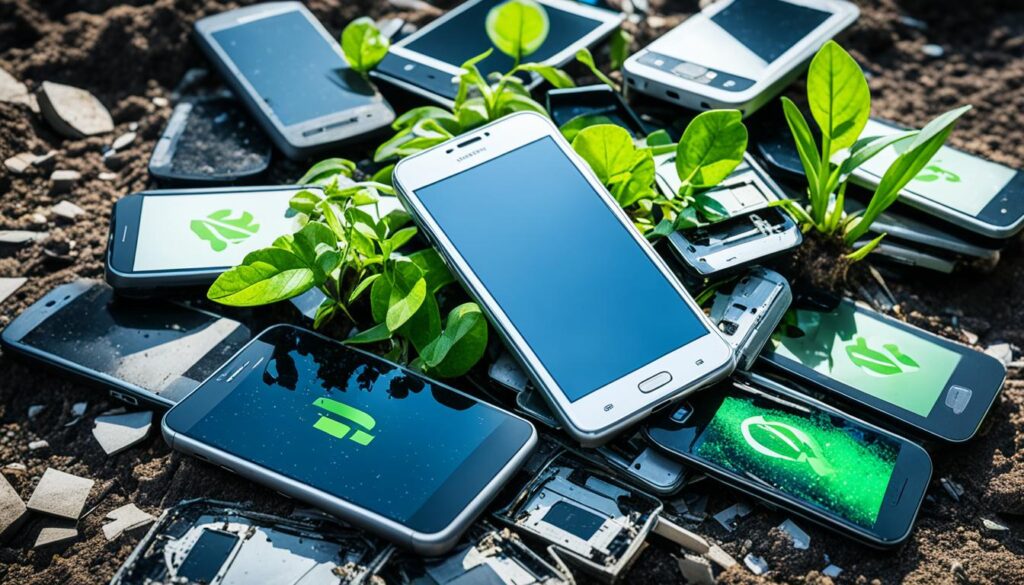
In order to contribute to a more sustainable tech ecosystem, it is essential for consumers to adopt best practices for smartphone recycling. By following eco-friendly disposal methods and implementing consumer tips, individuals can significantly reduce e-waste and maximize the environmental benefits of recycling.
One of the first steps in smartphone recycling is to properly dispose of your device. Instead of throwing it in the trash, explore the various options available for recycling. Local collection points and e-waste centers are convenient drop-off locations where you can deposit your old smartphones for recycling. Mail-in recycling programs and retailer take-back initiatives also provide easy and accessible avenues for recycling.
Before recycling your smartphone, it is important to ensure that your personal data is secure. Perform a data backup and factory reset to protect your information from falling into the wrong hands. Remove SIM and SD cards from your device to prevent any potential data breaches.
Assessing the condition of your smartphone is another crucial step in the recycling process. If the device is still in working condition, consider donating it to charities or non-profit organizations that accept used smartphones. This gives your device a second life and allows someone else to benefit from it.
To further reduce e-waste, consumers can also practice sustainable habits when it comes to upgrading their smartphones. Instead of automatically replacing your device with the latest model every time it is available, consider extending the lifespan of your current smartphone. Regular maintenance, such as replacing batteries or repairing broken screens, can help prolong the life of your device and reduce electronic waste.
By implementing these best practices, consumers can play a significant role in smartphone recycling and contribute to a more eco-friendly disposal process. Together, we can make a positive impact on the environment and create a sustainable future for our tech devices.
Conclusion
In conclusion, eco-friendly smartphone disposal is crucial for minimizing the environmental impact of our tech devices and promoting sustainability. Throughout this guide, we have explored the importance of smartphone recycling and provided essential information on how to properly dispose of our old devices.
Key takeaways for eco-friendly smartphone disposal include responsibly preparing your device for recycling by backing up data, factory resetting, and removing SIM and SD cards. It is equally important to choose a responsible smartphone recycler who follows certified e-waste recycling standards and prioritizes data security.
However, our green tech journey should not end with recycling. By continuing to make sustainable choices in our tech consumption and disposal practices, we can contribute to a greener future. This journey involves reducing e-waste, maximizing the lifespan of our devices, and exploring options for repair and refurbishment.
To encourage wider adoption of smartphone recycling practices, it is important to educate others about the environmental impact of electronic waste and the benefits of recycling. By sharing our knowledge and experiences, we can inspire individuals, communities, and businesses to prioritize eco-friendly tech practices and contribute to a more sustainable world.
FAQ
Why is smartphone recycling important?
Smartphone recycling is important because it helps reduce e-waste, minimize the carbon footprint of smartphone manufacturing and disposal, and contribute to resource conservation.
What is the environmental impact of smartphones?
Smartphones have a significant environmental impact, including the generation of e-waste, carbon emissions from manufacturing and disposal, and the depletion of valuable resources.
What is e-waste and why is it a concern?
E-waste refers to electronic waste, including old smartphones, that are improperly disposed of. It is a concern because it can release toxic substances into the environment and contribute to pollution and habitat destruction.
How does smartphone manufacturing and disposal contribute to carbon emissions?
Smartphone manufacturing and disposal processes consume energy and release greenhouse gases like carbon dioxide, contributing to climate change and global warming.
Why is resource depletion a concern related to smartphones?
Smartphones contain valuable resources such as rare-earth metals and precious metals that are finite and non-renewable. By recycling smartphones, we can conserve these resources and reduce the need for raw material extraction.
What is the lifecycle of a smartphone?
The lifecycle of a smartphone includes the stages of manufacturing, distribution, use, and end-of-life. Understanding the entire lifecycle is crucial for comprehending the environmental impact and identifying opportunities for sustainable practices.
How can I prepare my smartphone for recycling?
To prepare your smartphone for recycling, it is important to back up your data and perform a factory reset to protect your personal information. You should also remove SIM and SD cards and assess the condition of your smartphone for recycling options.
Where can I recycle my smartphone?
You can recycle your smartphone at local collection points and e-waste centers, participate in mail-in recycling programs, or take advantage of retailer take-back initiatives that provide convenient and accessible recycling options.
What happens during the smartphone recycling process?
The smartphone recycling process involves the collection of old devices, their transportation to recycling facilities, and the separation of materials for further processing. This allows for the recovery of valuable components and the proper disposal of hazardous materials.
How can I choose a responsible smartphone recycler?
To choose a responsible smartphone recycler, look for certified e-waste recyclers who follow proper handling and disposal practices. Ask questions about their recycling standards and consider their approach to data security.
What are some best practices for smartphone recycling?
Best practices for smartphone recycling include using eco-friendly disposal methods, reducing e-waste through proper recycling, and maximizing the environmental benefits of recycling by following sustainable practices.
What are the key takeaways for eco-friendly smartphone disposal?
The key takeaways for eco-friendly smartphone disposal are the importance of recycling, the need to continue the green tech journey beyond recycling, and the role individuals can play in encouraging wider adoption of smartphone recycling practices.
Smartphone Antenna Location Explained
Have you ever wondered where the antenna in your smartphone is located? You might be surprised to learn that it’s not always as straightforward as you might think. The internal antenna in smartphones plays a crucial role in ensuring proper signal reception and connectivity. Understanding its placement can help you optimize your device’s performance and signal strength. In this article, we will explore the various aspects of smartphone antenna location and how it has evolved over time.
Understanding the Role of Antennas in Smartphones
Antennas are essential components in smartphones that enable wireless communication. They play a crucial role in ensuring that your device can receive and transmit signals for various functionalities, such as making calls, browsing the internet, and using GPS services.
The Functionality of Antenna Lines
One common feature you may notice on smartphones is the presence of antenna lines. These lines, often seen as plastic stripes on the edges of the device, serve a vital function in optimizing signal reception. While they may seem like mere aesthetic features, they play a significant role in allowing radio waves to pass through the materials of the smartphone and connect to the internet.
Plastic Stripes: More Than Aesthetic Features
The plastic stripes on smartphones act as a passageway for radio waves. They help to minimize signal interference by providing a clear path for wireless signals to travel through the device. Without these antenna lines, signal strength may be compromised, leading to poor call quality and slower internet speeds. Manufacturers strategically position these lines to ensure optimal signal reception throughout the device.
Why Metal and Glass Designs Require Antenna Lines
With the rise of metal and glass designs in smartphones, you may wonder why antenna lines are still necessary. These materials can hinder the ability of radio waves to pass through, resulting in reduced signal strength. To overcome this challenge, manufacturers incorporate antenna lines into the design to maintain optimal signal reception. By carefully integrating the lines, smartphones can balance aesthetics with signal functionality.
Understanding the role of antennas and the importance of antenna lines in smartphones is crucial for maximizing your device’s signal reception and overall connectivity.
| Antenna Technology | Benefits |
|---|---|
| Internal Antennas | Improved signal reception |
| Antenna Lines | Optimized signal transmission |
| Built-in Antennas | Sleek design without compromising connectivity |
Where Is the Antenna on Smartphones
The location of antennas in smartphones varies depending on the device’s design and internal components. Common areas where antennas are found include near the top, bottom, or sides of the device. The precise placement of the antenna is crucial for optimizing signal reception and overall connectivity.
Manufacturers strategically position the antennas to ensure they are not obstructed by other internal components or external factors such as a user’s hand or surrounding objects. By placing the antennas in specific locations, smartphones can achieve better signal strength and mitigate interference.
Let’s explore the specific locations where antennas are commonly placed in smartphones:
- Near the top: Many smartphones have antennas positioned near the top of the device. This placement allows for better signal reception when the device is held in the typical upright position during calls or internet usage.
- Near the bottom: Some smartphones have antennas located near the bottom of the device. This placement is ideal for optimizing signal reception when the device is held in landscape orientation or when there may be obstructions near the top of the device.
- Along the sides: Antennas can also be found along the sides of smartphones. This placement enables better signal reception regardless of how the device is held or oriented.
It’s important for users to be aware of the antenna placement in their smartphones. By understanding where the antenna is located, users can avoid covering it with their hand or obstructing the signal with accessories or cases that interfere with antenna reception.
Optimizing signal reception can lead to improved call quality, faster internet speeds, and a better overall smartphone experience.
Evolution of Smartphone Antenna Design

Smartphone antenna designs have come a long way since the early days of protruding antennas. Manufacturers have continuously advanced antenna technology to improve signal reception and enhance the user experience. Today, we have sleek in-built antennas that seamlessly integrate into the aesthetic design of modern devices.
The transition from protruding to in-built antennas has been driven by the desire for more compact and streamlined smartphone designs. In the past, protruding antennas were necessary to achieve optimal signal reception due to the limited space inside the devices. However, advancements in antenna technology have enabled manufacturers to embed the antennas within the smartphone’s internal components.
This evolution in antenna design has not only improved the aesthetics of smartphones but also enhanced their functionality. With in-built antennas, users no longer have to worry about antennas sticking out or getting damaged. Additionally, the integration of antennas within the device allows for better signal reception without compromising the overall performance of the smartphone.
As smartphones continue to evolve, we can expect further advancements in antenna technology. Manufacturers are constantly exploring innovative ways to enhance signal reception, cater to different frequency bands, and improve connectivity. The evolution of smartphone antenna design showcases the commitment of the industry to provide users with seamless communication experiences.
| Protruding Antennas | In-Built Antennas |
|---|---|
| Required external placement | Embedded within the device |
| Visible and prone to damage | Sleek and protected |
| Limited design options | Seamless integration with device design |
| Potential signal interference | Improved signal reception |
The Intricacies of Smartphone Antenna Placement
Antenna placement in smartphones presents unique challenges, especially with the increasing popularity of full-screen designs. In order to provide users with optimal signal reception while maximizing screen space, smartphone manufacturers must employ innovative solutions for antenna positioning.
The Challenge of Antenna Positioning in Full-Screen Designs
In full-screen smartphones, the available space for antenna placement is significantly reduced compared to traditional designs. This limitation requires antenna engineers to carefully consider alternative locations and methods that won’t interfere with the device’s aesthetics or functionality. The goal is to strike a balance between signal reception and user experience.
Impact of Human Interaction on Signal Reception
Human interaction with smartphones can have a significant impact on signal reception. When users hold their devices in certain ways or obscure the antenna area with their hands, signal quality can be compromised. This phenomenon, commonly known as the “death grip,” can result in decreased signal strength and slower data speeds.
To mitigate the negative effects of human interaction on signal reception, smartphone manufacturers implement various design strategies such as antenna diversity, which allows devices to switch between different antennas to maintain a strong connection. Additionally, users can optimize signal strength by holding their smartphones in a position that minimizes interference with the antenna.
Optimizing signal reception in full-screen smartphones and accounting for human interaction are ongoing challenges for smartphone manufacturers. By continually improving antenna placement techniques and user education, the industry strives to provide users with seamless connectivity and exceptional mobile experiences.
Antenna Diversity and Its Impact on Connectivity

Antenna diversity is a powerful technique utilized in smartphones to significantly improve connectivity and enhance signal strength. This innovative approach involves the incorporation of multiple antennas in a single device, allowing for the seamless switching between different signals and frequencies. By intelligently selecting the strongest available signal, smartphones with antenna diversity can deliver a more stable and reliable connection.
The impact of antenna diversity on connectivity is profound. Through the utilization of multiple antennas, smartphones can enhance their ability to receive and transmit signals, resulting in improved network performance. This is especially beneficial in areas with weak signal coverage or high network congestion. Users can experience fewer dropped calls, faster data speeds, and overall improved signal strength and reliability.
Moreover, antenna diversity plays a crucial role in improving phone signal strength, particularly in scenarios where a single antenna may struggle to capture signals. By combining the signals from multiple antennas, smartphones can achieve a more robust and consistent connection, even in challenging radio frequency environments. This proves particularly advantageous in urban areas with tall buildings or remote regions with limited network infrastructure.
In addition to signal strength and network performance improvements, antenna diversity also helps mitigate the effects of interference. Multiple antennas can intelligently identify and minimize signal interference, resulting in clearer voice calls, reduced data packet loss, and enhanced overall user experience.
Overall, the implementation of antenna diversity in smartphones has a transformative effect on connectivity and signal strength. By harnessing the power of multiple antennas, smartphones can overcome signal limitations and improve the user’s wireless experience.
To visually illustrate the concept of antenna diversity in smartphones, refer to the following diagram:
| Advantages of Antenna Diversity | Disadvantages of Antenna Diversity |
|---|---|
|
|
The table above outlines the advantages and disadvantages of antenna diversity in smartphones. While antenna diversity offers remarkable benefits, including improved signal reception and network performance, it also comes with increased complexity, higher power consumption, and additional cost as tradeoffs.
The Future of Smartphone Antennas: 5G and Beyond
With the rapid advancement of technology, smartphone antennas are continually evolving to meet the demands of emerging connectivity standards, particularly with the advent of 5G. This next generation of wireless technology promises faster data speeds, lower latency, and greater network capacity, making it essential for smartphone antennas to keep up.
MIMO Technology: Enabling Faster Data Speeds
One of the key technologies that will shape the future of smartphone antennas is Multiple-Input Multiple-Output (MIMO). MIMO technology utilizes multiple antennas to transmit and receive signals simultaneously, resulting in improved data speeds and overall network performance. With MIMO, smartphones will be able to handle larger volumes of data and deliver seamless experiences in bandwidth-intensive applications such as video streaming and online gaming.
Antenna Designs Catering to High-Frequency 5G Bands
As 5G operates on higher frequency bands compared to previous generations, smartphone antennas need to adapt to these changes. Antenna designs specifically optimized for the high-frequency 5G bands will be crucial for ensuring optimal signal reception and maximizing the potential of this advanced wireless technology. These new antenna designs will enable smartphones to leverage the full capabilities of 5G networks, offering users faster download and upload speeds, improved network reliability, and enhanced overall performance.
As we move into the era of 5G and beyond, smartphone antennas will play a vital role in delivering the full potential of these cutting-edge networks. Through innovations such as MIMO technology and specialized antenna designs, smartphones will be equipped to provide faster data speeds, seamless connectivity, and improved user experiences.
Source Links
Navigating Smartphones and Social Media Trends
Did you know that over 3.8 billion people around the world use smartphones, and the average user spends about 3 hours and 15 minutes per day on social media platforms? That’s a staggering amount of time dedicated to digital engagement.
In this article, we will delve into the ever-evolving relationship between smartphones and social media. We’ll explore the latest trends in smartphones usage, examine the impact of social media on smartphone users, and discuss strategies for optimizing smartphones for seamless social media interaction.
Key Takeaways:
- Over 3.8 billion people use smartphones worldwide, and the average user spends around 3 hours and 15 minutes on social media daily.
- Understanding smartphones and social media trends is crucial for effective digital engagement.
- Optimizing smartphones for social media interaction can enhance user experiences and increase online presence.
- Stay tuned as we explore the emerging social media platforms, enhancements in established networks, the impact of short-form video content, the role of influencers, and strategies for developing valuable social media communities.
- By leveraging the latest trends in smartphones and social media, businesses can optimize their digital marketing strategies and connect with their target audience more effectively.
Emergence of Novel Social Media Platforms
The social media landscape is constantly evolving, with new platforms emerging and challenging established players. These emerging social media platforms offer users alternative options and unique features that cater to niche audiences.
New Challenger Apps Entering the Market
One notable trend is the introduction of new social media apps that are entering the market. These apps aim to captivate users with innovative functionalities and fresh approaches to social networking. They provide users with exciting features and different user experiences compared to traditional social media platforms. The rapidly evolving nature of the digital world creates opportunities for new players to disrupt the market and gain traction among specific target audiences. This dynamic ecosystem encourages healthy competition and drives continuous innovation in the social media industry.
Shift Towards Augmented Reality in Social Apps
A significant development in social media apps is the integration of augmented reality (AR) features. Augmented reality technology enhances the user experience by overlaying digital elements onto the real world. AR in social apps allows users to engage with interactive and immersive content, blurring the line between the virtual and physical realms. From AR filters in selfie apps to AR lenses in video applications, these features provide users with creative tools to express themselves and engage with their followers. The integration of augmented reality creates new opportunities for storytelling, visual experiences, and brand collaborations within the social media landscape. With AR technology rapidly advancing, social apps are becoming more visually compelling and interactive, revolutionizing how users engage with content.
| New Social Media Apps | Unique Features | Target Audience |
|---|---|---|
| TikTok | Short-form vertical videos | Youthful and creative individuals |
| Clubhouse | Audio-only chat rooms | Audio enthusiasts and thought leaders |
| Venmo | Social payment and money transfer | Millennials and Gen Z |
| Visual discovery and inspiration | Creative individuals and hobbyists |
Image related to the section:
Enhancements in Established Social Networks

Established social media platforms like Facebook, Instagram, Twitter, and LinkedIn are constantly evolving to provide users with enhanced and engaging experiences. These platforms go beyond their initial functionalities and continuously introduce updates and enhancements to keep up with the ever-changing digital landscape.
One notable area of improvement in these social networks is the expansion into e-commerce. Platforms like Facebook and Instagram have integrated shopping features, allowing users to discover and purchase products directly on the platforms. This seamless integration between social media and e-commerce provides a convenient and streamlined shopping experience for users, promoting increased engagement and revenue opportunities for businesses.
Furthermore, established social networks are focusing on creating interactive experiences for users. Features such as live videos, stories, and interactive polls encourage users to actively engage with content and connect with their peers. By promoting user interactions and conversations, these platforms foster a sense of community and increase user satisfaction.
Monetization options have also become a significant focus for established social media platforms. With the rise of influencer marketing and the demand for sponsored content, platforms like Instagram and YouTube have introduced monetization programs that allow content creators to generate income from their posts. These programs enable influencers to utilize their platforms effectively, create high-quality content, and monetize their influence.
Overall, the continuous enhancements in established social networks aim to provide users with a more immersive and personalized social media experience. By expanding into e-commerce, offering interactive features, and implementing monetization options, these platforms are evolving to meet the changing needs and expectations of their users.
Smartphones and Social Media: A Symbiotic Growth
Smartphones and social media are two intertwined aspects of our digital world. As smartphones continue to evolve, they bring forth new features that enhance our social media experiences. From improved cameras to faster processors and larger screens, smartphones have revolutionized the way we interact with social media platforms. This section will explore the evolving features of smartphones and how they impact social media usage.
Evolving Features in Smartphone Technology
Smartphones have come a long way since their inception. Today’s smartphones offer advanced features that cater to our ever-growing digital needs. The continuous evolution of smartphone technology has paved the way for better cameras, allowing us to capture high-quality photos and videos for our social media posts. In addition, faster processors enable smoother performance, ensuring seamless browsing and multitasking on social media platforms. The larger screens provide a more immersive experience, making it easier to engage with content on social media.
Furthermore, smartphones now come equipped with artificial intelligence (AI) capabilities that enhance our social media experiences. AI-powered features like facial recognition, photo editing, and predictive text help us create compelling content and engage with our networks more efficiently.
Strategic Integration of Advanced Social Media Apps
In addition to improving the hardware, smartphone manufacturers are also focusing on strategic integration of advanced social media apps. This ensures that users have seamless access to their favorite social media platforms and can easily navigate through the apps. Smartphone manufacturers collaborate with social media giants to optimize the user experience and provide dedicated features tailored to specific platforms.
The integration of social media apps goes beyond the traditional presence on smartphones. Many smartphone manufacturers now offer pre-installed social media apps that are deeply integrated into their operating systems. This integration enables users to interact with social media directly from their phone’s home screen, receive notifications, and access advanced features without having to open the individual apps.
The strategic integration of advanced social media apps also allows for a more personalized social media experience. Smartphone manufacturers use artificial intelligence algorithms to understand users’ preferences and tailor content suggestions accordingly. This ensures that users are presented with relevant and engaging content that aligns with their interests.
As smartphones and social media continue to evolve, their symbiotic growth remains evident. The advancements in smartphone technology and the strategic integration of advanced social media apps contribute to a seamless and immersive social media experience. Users can now effortlessly capture and share moments, connect with their social networks, and stay updated with the latest trends, all from the palm of their hands.
Impact of Short-Form Video Content

Short-form video content has revolutionized the social media landscape, with platforms like TikTok and Instagram Reels leading the way. These bite-sized videos have quickly gained immense popularity, captivating users and creating a new form of online entertainment.
The viral nature of short-form videos is undeniable. Their quick and engaging format makes it easy for users to consume and share content, resulting in widespread reach and exposure. With just a few seconds, a well-crafted video can capture the attention of millions, leading to increased brand visibility and recognition.
Platforms like TikTok and Instagram have recognized the potential of short-form video content and have implemented monetization strategies to empower content creators. Through features like brand partnerships, sponsored content, and in-app purchases, these platforms offer opportunities for creators to generate income from their content.
By tapping into the impact of short-form video content and understanding the viral nature of bite-sized media, content creators and brands can effectively leverage these platforms to reach a wider audience and drive engagement. With the right monetization strategies in place, social media platforms have become a lucrative space for content creation and brand promotion.
The Role of Influencers in Shaping Online Trends
Influencers play a significant role in shaping online trends and influencing consumer behavior. With the rise of social media platforms, influencers have gained immense popularity and have become powerful voices in the digital space.
These individuals have the ability to connect with their audience authentically, often sharing personal experiences, product recommendations, and lifestyle tips. Their genuine approach resonates with users, leading to increased engagement and trust.
Moreover, influencers employ various strategies to build their following and maintain a strong online presence. They consistently create high-quality content, collaborate with brands, engage with their audience through comments and direct messages, and stay on top of current trends.
One interesting phenomenon within the influencer landscape is the rise of micro-influencers. These individuals have smaller but highly engaged followers, often within specific niche markets. Their niche content appeals to targeted audiences, allowing brands to reach a more specialized group of consumers.
The impact of influencers goes beyond just promoting products and services. They have the power to shape public opinion, introduce new ideas and concepts, and even initiate social change. Brands recognize the influence influencers wield and often partner with them to amplify their marketing efforts and tap into their dedicated fan base.
In conclusion, influencers have become key players in shaping online trends. Their authentic connections with followers, strategic content creation, and ability to tap into niche markets make them invaluable to brands and marketers. As social media continues to evolve, influencers will undoubtedly continue to play a pivotal role in shaping the digital landscape.
Developing Valuable Social Media Communities

Building valuable social media communities is crucial for brands and individuals alike. It provides a platform for interaction, engagement, and fostering brand loyalty. In this section, we will explore effective strategies for developing thriving communities on social media platforms.
Encouraging User Participation Through Interactive Features
One key aspect of nurturing social media communities is encouraging user participation through interactive features. These features invite users to actively engage with the content, fostering a sense of belonging and connection. One popular method is the use of polls and quizzes that enable users to share their opinions or test their knowledge. This not only encourages participation but also generates valuable insights and feedback for brands.
Another interactive feature is the inclusion of user-generated content. By encouraging users to contribute their own content, such as photos, testimonials, or reviews, brands can create a sense of community ownership and pride. User-generated content not only boosts engagement but also serves as social proof, influencing others to join the community and engage with the brand.
Fostering Brand Loyalty via Community Engagement
Community engagement plays a vital role in fostering brand loyalty. When brands actively engage with their community, they show that they value their customers and are genuinely interested in their opinions and feedback. This can be achieved through responding to comments, addressing customer queries, and even featuring user-generated content.
By building a strong relationship with their community, brands can create a loyal customer base that not only supports and advocates for the brand but also becomes an essential part of its growth. Engaging with the community also provides brands with the opportunity to gather valuable insights, understand customer needs and preferences, and tailor their offerings accordingly, further strengthening brand loyalty.
To effectively foster brand loyalty through community engagement, brands should prioritize regular interaction, provide personalized responses, and create an inclusive and supportive environment where community members feel valued and appreciated.
| Benefits of Developing Social Media Communities |
|---|
| Increased brand visibility and awareness |
| Enhanced customer engagement and satisfaction |
| Opportunity for valuable user-generated content |
| Insights and feedback for product/service improvements |
| Stronger brand loyalty and customer advocacy |
Table: Benefits of Developing Social Media Communities
Conclusion
In conclusion, adapting to the continuous transformation in social networking is crucial for businesses and marketers. The ever-changing landscape of smartphones and social media demands constant vigilance to stay ahead of the curve. By staying abreast of the latest trends and developments in these areas, businesses can optimize their digital marketing strategies and enhance their online presence.
It is essential to recognize the impact of smartphones and social media on consumer behavior and adapt accordingly. Leveraging these trends effectively allows businesses to engage with their target audience more successfully and drive desired outcomes. Whether it’s incorporating new features, exploring emerging platforms, or embracing short-form video content, staying proactive is key to staying relevant.
Adapting to Social Networking Transformation
Adapting to social networking transformation entails being agile and responsive to evolving user preferences and behaviors. It involves understanding the shifts in consumer expectations, technological advancements, and the influence of social media trends. By keeping pace with these changes, businesses can position themselves as industry leaders and create meaningful connections with their audience.
Leveraging Trends for Effective Digital Marketing Strategies
To achieve effective digital marketing strategies, businesses must consistently leverage the latest trends and insights in smartphones and social media. This requires a comprehensive understanding of the target audience, their preferences, and the platforms they engage with. By aligning marketing efforts with these trends, businesses can create compelling content and campaigns that resonate with their audience and drive measurable results.
Source Links
How Smartphones Use Magnets: Unveiling Tech Secrets
Have you ever wondered how your smartphone utilizes magnets for various functions? From speakers and microphones to vibration motors and magnetic sensors, magnets play a crucial role in the functionality and features of smartphones. In this article, we will delve into the world of smartphone magnet technology, exploring the different magnetic components in smartphones and their applications. Get ready to unveil the tech secrets behind how smartphones use magnets to enhance user experience and functionality.
Key Takeaways:
- Smartphones utilize magnets for various functions and feature enhancements.
- Magnetic components in smartphones include speakers, microphones, vibration motors, and sensors.
- Magnets play a crucial role in smartphone accessories like car mounts and wireless charging pads.
- Smartphones utilize magnetometers for navigation and compass applications.
- Magnets also revolutionize smartphone security with authentication systems and enhanced payment security.
The Invisible Influence: How Magnets Power Your Smartphone Experience
Magnets have a hidden influence on our smartphone experience, powering various features and functions. They play a crucial role in enhancing user experience and functionality. Let’s explore how magnets are integrated into smartphones and their impact on our daily lives.
Smartphones are equipped with magnetic components that contribute to their overall functionality. These components include magnet sensors, which detect changes in the surrounding magnetic field. The data collected by these sensors enables the smartphone to perform various tasks and provide users with a seamless experience. From auto-rotate screen orientation to detecting the presence of a flip cover, magnet sensors enhance the usability and convenience of our smartphones.
Magnetic features in smartphones are also responsible for powering essential functions. One such example is the vibration motor, which provides haptic feedback during notifications or alerts. This motor relies on the interaction between magnets to create vibrations, adding a tactile element to our smartphone experience.
Furthermore, magnets are crucial in the functioning of speakers and microphones in smartphones. They help in producing sound by interacting with the voice coil, which generates audio signals. Magnets are also involved in the tuning and amplification of these sound waves, resulting in the high-quality audio we enjoy while using our smartphones.
Innovation with magnets has further revolutionized smartphone technology. One notable example is the use of magnetic attachments, such as magnetic chargers and mounting systems. These attachments provide users with convenient and efficient ways to charge their devices and secure them in various settings, respectively. Magnetic attachments not only simplify our everyday activities but also enhance the versatility of smartphones.
In conclusion, magnets are an invisible yet powerful force that powers our smartphone experience. They contribute to the functionality, convenience, and innovation we find in modern smartphones. From magnet sensors to magnetic attachments, the seamless integration of magnets in smartphones enhances user experience and brings us closer to the future of mobile technology.
Magnetic Components in Smartphones: An Overview
Smartphones are equipped with various magnetic components that contribute to their functionality and features. In this section, we will provide an overview of these magnetic components and their role in smartphones.
Speakers and Microphones: The Role of Magnets
Magnets play a crucial role in the functioning of speakers and microphones in smartphones. By utilizing the power of magnets, smartphones are able to produce high-quality sound and capture clear audio. In speakers, magnets are used to drive the diaphragm, creating vibrations that generate sound waves. On the other hand, microphones use magnets to convert sound waves into electrical signals, allowing users to communicate effectively during phone calls and voice recordings.
Vibration Motors: Powered by Magnetism
Smartphones also feature vibration motors that provide haptic feedback, alerting users to incoming notifications, calls, and other interactions. These motors rely on the power of magnets to create rapid vibrations, producing the desired tactile response. By carefully controlling the magnetic field, smartphones can offer different vibration patterns and intensities, enhancing user experiences and interactions with the device.
Magnetic Sensors: Enriching Functionality
Magnetic sensors are another important component found in smartphones. These sensors detect and measure magnetic fields, enabling various functionalities and features. For example, smartphones use magnetic sensors to determine the device’s orientation and provide accurate compass readings. Additionally, they are used in magnetometers to detect magnetic fields from external sources, enhancing navigation and location-based services. Magnetic sensors in smartphones open up a wide range of possibilities, from augmented reality experiences to precise navigation and beyond.
How Do Smartphones Use Magnets?
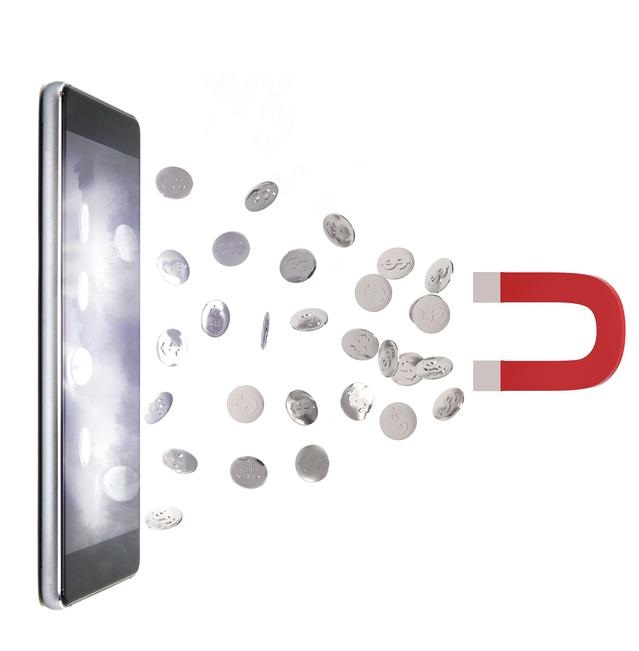
In the world of smartphones, magnets play a vital role in enhancing functionality and providing innovative features. From magnetic attachments to secure phone holders, smartphones have various applications for magnets. Let’s explore the fascinating ways in which smartphones utilize magnets for a better user experience.
One of the key uses of magnets in smartphones is for magnetic data transfer. By using magnetic connectors or adapters, smartphones can transfer data quickly and securely. This technology eliminates the need for traditional physical connectors, making data transfer more convenient for users.
Another application of magnets in smartphones is the integration of magnetic sensors. These sensors detect magnetic fields and enable features such as compass functionality and magnetic field detection. They enhance the smartphone’s capability to provide accurate direction and detect the presence of magnetic objects or fields.
Smartphones also utilize magnets for innovative features, such as magnetic phone cases and magnetic stands. These accessories use magnets to securely hold the smartphone in place, providing convenience and stability. Additionally, magnets are utilized in wireless charging pads for easy and efficient charging.
Through these various applications, magnets contribute to the overall functionality and versatility of smartphones. They enhance the user experience and provide convenient solutions for data transfer, secure phone holding, and charging.
So, the next time you use your smartphone and wonder how it achieves its remarkable capabilities, remember the role that magnets play behind the scenes. They are the unsung heroes powering your smartphone’s functionality and enhancing your digital experience.
Navigation and Compass Apps: Guided by Earth’s Magnetism
Have you ever wondered how navigation and compass apps on your smartphone accurately determine your direction? In this section, we will explore the role of magnets in navigation and compass apps. We will discuss how smartphones utilize magnetometers, also known as magnetometers, to detect the Earth’s magnetic field and provide accurate compass readings. Discover how magnets guide your smartphone’s navigation and compass apps.
Navigation and compass apps have become an integral part of our daily lives, helping us find our way in unknown places and ensuring we’re always on the right track. But have you ever wondered how these apps precisely determine our direction and point us in the right way? The secret lies in the integration of magnetic field sensors, known as magnetometers, in our smartphones.
Smartphones are equipped with a magnetic field sensor, also known as a magnetometer, which detects the Earth’s magnetic field. This sensor allows navigation and compass apps to accurately determine the user’s orientation and provide reliable compass readings. By utilizing the magnetic field sensor in smartphones, these apps can effectively guide users to their desired destinations.
The magnetometer in smartphones measures the strength and direction of the Earth’s magnetic field. This information is then processed by the smartphone’s software to calculate the device’s orientation and display it on the screen. Whether you’re walking, driving, or hiking, navigation and compass apps rely on this technology to ensure accurate and reliable direction guidance.
Smartphone compass technology has come a long way, and advancements in magnetometer technology have made navigation apps more precise and reliable than ever before. With the integration of magnetometers in smartphones, users can confidently navigate unfamiliar areas and explore the world with ease.
The Science Behind Magnetic Phone Accessories
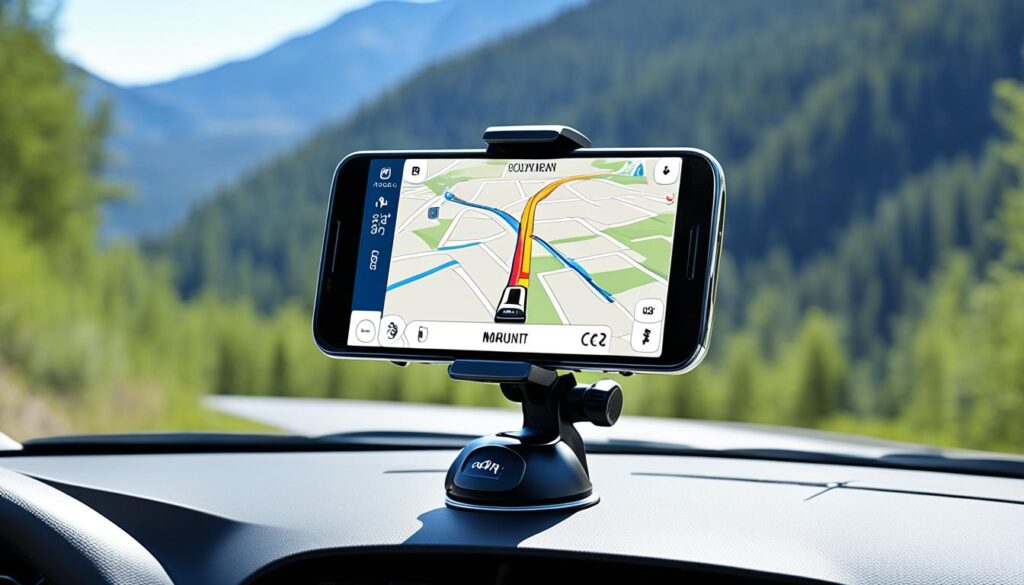
Magnetic phone accessories have gained popularity in recent years. These innovative accessories utilize the power of magnets to enhance convenience and functionality in smartphone usage. In this section, we will explore the science behind magnetic phone accessories and their integration with smartphones, providing a deeper understanding of their benefits and features.
Magnetic Car Mounts: Convenience Meets Technology
Magnetic car mounts are one of the most popular magnetic phone accessories. By utilizing a strong magnetic base, these mounts securely hold your smartphone in place while driving. The convenience of a magnetic car mount allows you to easily access your phone for navigation, music control, or hands-free calling. The powerful magnets ensure a secure and stable hold, keeping your smartphone within reach and providing a safer driving experience.
Wireless Charging Pads: The Magnetic Connection
Wireless charging pads have revolutionized the way we charge our smartphones. These pads use magnetic induction to transfer power from the pad to the smartphone without the need for cables. The magnetic connection between the pad and the smartphone allows for effortless charging by simply placing the device on the pad. The magnets ensure proper alignment and optimal charging efficiency, making wireless charging a convenient and hassle-free experience.
| Magnetic Phone Accessory | Function |
|---|---|
| Magnetic Car Mount | Securely holds smartphones in cars for easy access and safer driving |
| Wireless Charging Pad | Enables convenient, cable-free charging through magnetic induction |
As demonstrated by the table above, magnetic phone accessories offer various functions to enhance smartphone usage. Whether it’s the convenience of a magnetic car mount or the wireless charging capabilities of a magnetic charging pad, these accessories utilize the power of magnets to provide seamless integration with smartphones.
By understanding the science behind magnetic phone accessories, users can make informed decisions when choosing the right accessories for their smartphones. Whether it’s for convenience, functionality, or both, magnetic phone accessories offer an innovative and user-friendly way to enhance smartphone usage.
Magnetometers: The Sensor You Didn’t Know Your Phone Had
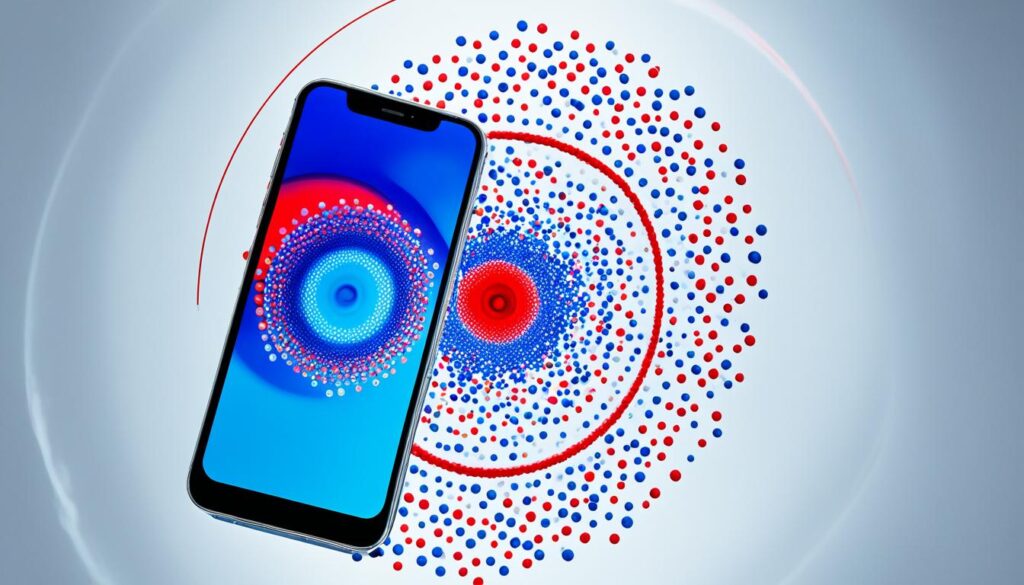
Did you know that your smartphone is equipped with a built-in magnetometer? This often-overlooked sensor is responsible for detecting and measuring magnetic fields. In this section, we will explore the role of magnetometers in smartphones and uncover the fascinating world of magnetic technology in cell phones.
A magnetometer is a small electronic component that is able to detect and measure magnetic fields. It works by utilizing the principles of magnetism and the interaction of magnetic fields with the sensor. This sensor is essential for various magnetic features and functionalities in your smartphone.
With the help of the magnetometer, your smartphone is able to provide accurate compass readings, detect magnetic attachments, and enable innovative magnetic functionalities. The magnetometer allows your phone to sense changes in magnetic fields and convert them into useful data that can be utilized by different applications and features.
For example, the magnetometer plays a crucial role in compass apps, guiding you in the right direction based on the Earth’s magnetic field. Additionally, it enables your phone to detect when a magnetic attachment, such as a phone case or a magnetic accessory, is connected, triggering specific actions or settings.
The use of magnetometers in smartphones showcases the constant innovation and integration of magnetic technology in cell phones. These sensors contribute to enhancing user experience and expanding the functionality of our beloved devices.
Next time you reach for your smartphone, remember the hidden sensor that enables various magnetic features and functionalities – the magnetometer. It’s just another example of how magnets are revolutionizing the world of smartphones.
Understanding Magnetic Interference with Smartphones
Magnets can have an impact on smartphones beyond their intended purposes. In this section, we will explore the effects of magnetic interference on signal reception and data transfer in smartphones. We will discuss how magnets can potentially weaken signals and affect the performance of your device. Additionally, we will address the myth of magnets erasing smartphone data and uncover the truth behind this belief. Gain a deeper understanding of how magnets can interfere with your smartphone’s functionality.
Effects on Signal Reception and Data Transfer
Magnetic interference can disrupt the signals that smartphones rely on for communication. The presence of strong magnetic fields near your device can cause disturbances in wireless signals, leading to dropped calls, slow internet connections, and poor reception.
Additionally, magnets placed near antennas or other critical components can distort electromagnetic waves, resulting in reduced signal strength. This interference can limit the range and reliability of your smartphone’s connectivity.
When it comes to data transfer, magnets can interfere with the performance of near-field communication (NFC) technology and wireless charging. Magnetic fields can disrupt the precise transfer of data and energy between devices, leading to slower transfer speeds or failed connections.
Can Magnets Really Erase Your Data?
There is a common misconception that magnets can erase smartphone data. However, this is largely a myth. The storage technology used in modern smartphones, such as flash memory, is not susceptible to magnetism like older magnetic storage devices.
While the magnetic field produced by a typical refrigerator magnet or magnetic smartphone case will not erase your data, it is still advisable to avoid placing magnets directly on your device. Strong magnets, such as those used in industrial settings or magnetic resonance imaging (MRI) machines, can potentially cause damage to your device’s internal components if they come into direct contact.
It’s important to note that most smartphones today are equipped with built-in magnetic sensors to detect and measure magnetic fields. These sensors can help your device provide interactive features like compass functionality and auto-rotate screens, but they are not powerful enough to erase your data.
By understanding the potential impact of magnets on your smartphone, you can take precautions to avoid interference and ensure optimal device performance.
The Curious Case of Magnetic Messaging
In this section, we will explore the curious case of magnetic messaging in smartphones. We will discuss how smartphones can utilize the magnetic field sensor, or magnetometer, to receive messages in the form of a varying magnetic field. Discover the potential of magnetic messaging and its applications in the world of smartphones.
Revolutionizing Smartphone Security with Magnets
Magnets are revolutionizing smartphone security in various ways. In this section, we will explore magnet-based authentication systems that enhance the security of smartphones. We will discuss how magnetic sensors play a role in these systems and provide an extra layer of protection. Additionally, we will explore how close-proximity magnetic signals can enhance payment security on smartphones. Discover the innovative ways magnets are securing your smartphone and personal information.
Magnet-Based Authentication Systems
Smartphone manufacturers are implementing magnet-based authentication systems to ensure secure access to devices. These systems utilize the smartphone’s magnetic sensor to detect and authenticate magnetic patterns generated by wearable devices or other digital accessories. By requiring the presence of a specific magnetic field, these systems enhance the security of user authentication, making it more difficult for unauthorized individuals to gain access to smartphones.
Enhanced Payment Security with Close-Proximity Magnetic Signals
The use of magnets in payment security has become increasingly popular. Close-proximity magnetic signals, also known as Magnetic Secure Transmission (MST), allow smartphones to securely transmit payment information to compatible payment terminals. By generating a unique magnetic field, smartphones can securely communicate with payment terminals, preventing unauthorized data interception. This technology provides an additional layer of security, ensuring safe and reliable mobile payments.
Smartphone Magnet Myths Debunked: The Real Effects of Neodymium Magnets
There are many myths and misconceptions surrounding the use of magnets in smartphones. In this section, we will debunk these myths and uncover the real effects of neodymium magnets in smartphones. Let’s separate fact from fiction and gain a clearer understanding of the role of neodymium magnets in your smartphone.
One common myth is that magnets can damage cell phones. While it is true that strong magnets can disrupt certain electronic devices, the neodymium magnets used in smartphones are specifically designed to have minimal interference. These magnets are strategically placed and shielded to prevent any negative impact on the device’s performance. So rest assured, your smartphone is built to withstand the presence of magnets.
Another misconception is that magnets can erase smartphone data. However, this is not the case. The neodymium magnets in smartphones are not powerful enough to erase or corrupt data. The data stored in your smartphone is safely stored on non-magnetic components, such as flash storage. So you can use magnets and magnetic accessories without worrying about losing your precious data.
So, what is the real effect of neodymium magnets in smartphones? These magnets play a crucial role in various magnetic features found in smartphones, including magnetic sensor technology, attachment systems, and accessories. They enhance the functionality and user experience of your device, allowing for easy attachment of magnetic accessories, such as car mounts and wireless chargers. These magnets are carefully calibrated to provide a seamless and secure connection.
Source Links
Smartphones & Internet: How Do They Connect?
Smartphones have become an indispensable part of our lives, allowing us to stay connected, access information, and navigate the digital world with ease. But have you ever wondered how smartphones connect to the internet? What enables these devices to access the vast realm of online content and services? Let’s unravel the mystery of smartphone internet connectivity and explore the inner workings of this seamless connection.
In this article, we will delve into the basics of smartphone internet connectivity, discussing the requirements for internet access on smartphones and the role of mobile data networks. We will also explore the realm of Wi-Fi connectivity and how smartphones can connect to public hotspots for internet access. Join us on this journey as we uncover the fascinating world of smartphone internet connectivity.
Key Takeaways:
- Smartphones rely on various technologies, such as cellular data networks and Wi-Fi, to establish an internet connection.
- Prerequisites for internet access on smartphones include a mobile phone that supports internet connectivity and a mobile phone service that offers data transmission.
- Mobile data networks, from 3G to 5G, play a crucial role in enabling internet access on smartphones.
- Wi-Fi connectivity allows smartphones to connect to wireless networks, including public hotspots, for internet access.
- Optimizing smartphone internet use and understanding network coverage and speed considerations are essential for a seamless online experience.
Understanding the Basics of Smartphone Internet Connectivity
In this section, we will delve deeper into the basics of smartphone internet connectivity. We will discuss the prerequisites for internet access on smartphones, the role of mobile data networks, and Wi-Fi connectivity and public hotspots.
Prerequisites for Internet Access on Smartphones
Before being able to connect to the internet on your smartphone, there are a few prerequisites that must be met. Firstly, your smartphone must support internet access. Most modern smartphones come with built-in internet capabilities. However, it is important to ensure that your device has the necessary hardware and software to connect to the internet.
Secondly, you need a mobile phone service that supports data transmission. This means having a cellular plan that includes mobile data. Without a data plan, your smartphone will not be able to access the internet unless connected to a Wi-Fi network.
The Role of Mobile Data: From 3G to 5G
Mobile data networks play a crucial role in enabling internet connectivity on smartphones. They allow your smartphone to connect to the internet while on the go, without the need for Wi-Fi. Mobile data networks have evolved over the years, with each generation offering faster speeds and better coverage.
Starting with 3G, which introduced basic internet access on smartphones, we now have 4G and the latest 5G technology. These advancements have revolutionized smartphone internet connectivity, enabling faster browsing, smoother video streaming, and more reliable connections.
With 5G, the next generation of mobile data networks, we can expect even faster download and upload speeds, reduced latency, and increased network capacity. This will further enhance the overall smartphone internet experience.
Wi-Fi Connectivity and Public Hotspots
In addition to mobile data networks, Wi-Fi connectivity is another key aspect of smartphone internet access. Wi-Fi allows smartphones to connect to local wireless networks, such as those at home, offices, cafes, or public hotspots.
Public hotspots are particularly useful when you are in areas with limited cellular network coverage or when you want to save on mobile data usage. These hotspots are available in various public places, including airports, hotels, restaurants, and libraries.
When connected to a Wi-Fi network, your smartphone can access the internet without using mobile data, providing a fast and reliable connection for browsing, downloading apps, streaming media, and more.
How Do Smartphones Connect to the Internet

In this section, we will specifically focus on how smartphones connect to the internet. Smartphones utilize different methods and technologies to establish an internet connection, ensuring seamless connectivity for users.
Cellular Data Networks:
Smartphones rely on cellular data networks to access the internet when Wi-Fi is unavailable. These networks provide connectivity through mobile service providers, enabling users to access the internet anywhere within network coverage. As technology has advanced, mobile data networks have evolved from 3G to the latest 5G technology, offering faster speeds and more reliable connections.
Wi-Fi Connectivity:
Smartphones are also capable of connecting to Wi-Fi networks for internet access. Wi-Fi technology allows users to connect to wireless networks, typically in homes, offices, or public areas with Wi-Fi hotspots. By connecting to Wi-Fi, smartphones can access the internet without relying on cellular data, providing cost savings and potentially faster speeds.
Whether smartphones connect through cellular data or Wi-Fi, the process of establishing an internet connection involves authentication and communication between the device and the network. Factors such as network availability, signal strength, and device settings can influence the quality of the connection.
Setting Up Your Smartphone for First-Time Internet Access
In order to access the internet on your smartphone, you need to set it up for internet access. This section will guide you through the necessary steps to get your smartphone connected to the internet for the first time.
Activating the Pre-Loaded Web Browser
Most smartphones come with a pre-loaded web browser that allows you to browse the internet. To activate the web browser, follow these steps:
- Open the settings menu on your smartphone.
- Scroll down and find the “Applications” or “Apps” section.
- Tap on the web browser application to open it.
- Follow the on-screen instructions to complete the activation process.
Once the web browser is activated, you can start using it to access websites and browse the internet.
Managing Bookmarks for Easy Access
Managing bookmarks on your smartphone can make it easier to access your favorite websites. Follow these steps to manage bookmarks:
- Open the web browser on your smartphone.
- Navigate to the website you want to bookmark.
- Tap on the bookmark icon, usually located in the top-right corner of the screen.
- Select “Add Bookmark” or “Bookmark this Page”.
- Choose a name for the bookmark and select a folder to save it in, if desired.
- Tap “Save” to add the bookmark to your collection.
To access your saved bookmarks, open the web browser and tap on the bookmarks icon. From there, you can select the bookmark you want to visit.
Downloading Content: Apps, Music, Videos, and More
Downloading content on your smartphone allows you to have apps, music, videos, and more available for offline access. Here’s how to download content:
- Open the app store on your smartphone.
- Search for the desired app, song, video, or other content.
- Tap on the content you want to download.
- Follow the on-screen instructions to complete the download process.
Once the download is complete, you can access the content from your smartphone, even without an internet connection.
Staying Secured: Ensuring Safe Browsing and Transactions
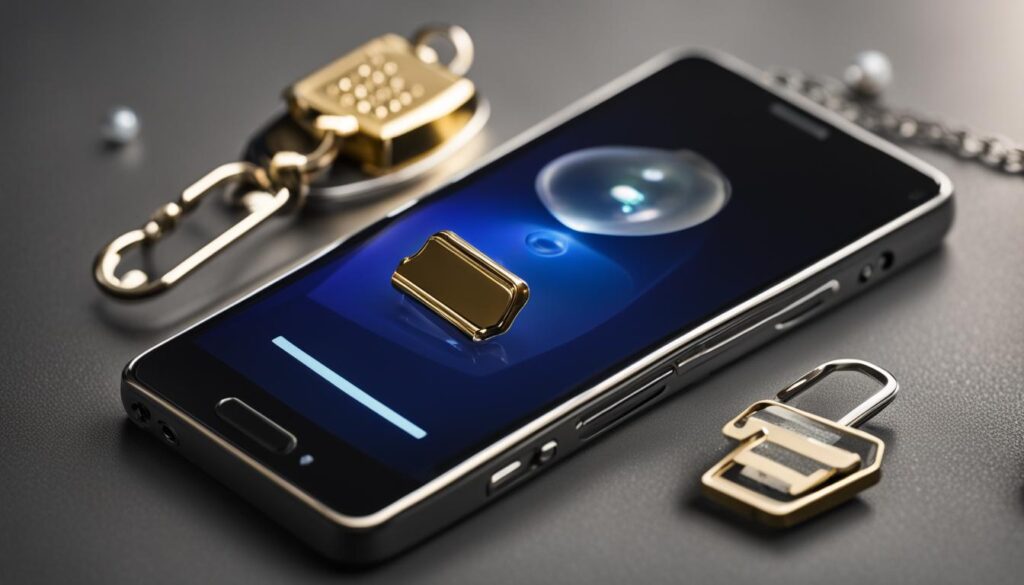
In today’s digital age, smartphone internet security is of paramount importance. Protecting your personal information while browsing the internet and conducting transactions on your smartphone is crucial to safeguarding your privacy and preventing unauthorized access. In this section, we will explore various measures you can take to ensure safe browsing and secure transactions on your smartphone.
Security Certificates and Safe Mobile Browsing
One of the key aspects of smartphone internet security is the use of security certificates. Security certificates establish a secure connection between your smartphone and the websites you visit, encrypting the data transmitted between them. This encryption helps prevent hackers and malicious actors from intercepting your information.
When browsing the web on your smartphone, always look for the padlock icon in the address bar, indicating that the website is using a security certificate. Additionally, make sure the website’s URL begins with “https://” instead of “http://”. The “s” in “https” stands for secure and signifies that the website has implemented security measures to protect your data.
Transferring and Downloading Security Credentials
Transferring and downloading security credentials securely is essential for maintaining smartphone internet security. Whether it’s passwords, authentication tokens, or other sensitive information, it’s crucial to use encrypted channels for transferring and downloading these credentials.
When transferring security credentials between devices or downloading them from cloud storage, ensure that you’re using secure and encrypted connections. Avoid using public Wi-Fi networks, as they may not provide adequate security. Instead, opt for private and trusted networks, such as your home Wi-Fi network or a secure mobile data connection.
Facial Recognition and Fingerprint Verification for Secure Access
Smartphones offer advanced security features such as facial recognition and fingerprint verification to ensure secure access to your device and online services. These biometric authentication methods add an extra layer of protection, making it difficult for unauthorized individuals to access your smartphone and personal data.
Enable facial recognition or fingerprint verification on your smartphone for secure and convenient access. These features use unique characteristics specific to you, such as your face or fingerprint, to authenticate your identity. By using biometric authentication, you can ensure that only authorized individuals can unlock your smartphone and access sensitive information.
By following these measures, you can enhance smartphone internet security and enjoy safe browsing and secure transactions on your device.
Wi-Fi and Smartphones: Harnessing Wireless Connectivity
In this section, we will delve into the topic of Wi-Fi connectivity and smartphones. We will discuss how smartphones can harness wireless connectivity through Wi-Fi technology. We will explain the process of connecting smartphones to Wi-Fi networks, including home networks and public hotspots. We will also cover the benefits and considerations of using Wi-Fi for internet access on smartphones.
Wi-Fi has revolutionized the way we connect to the internet. With Wi-Fi-enabled smartphones, users have the flexibility to access the internet without relying solely on mobile data networks. By connecting to Wi-Fi networks, smartphone users can enjoy faster speeds, more stable connections, and potentially save on their data usage.
To connect your smartphone to a Wi-Fi network, follow these simple steps:
- Unlock and navigate to the settings menu on your smartphone.
- Look for the Wi-Fi option in the settings menu and tap on it.
- Your smartphone will scan for available Wi-Fi networks in the vicinity.
- Select the desired Wi-Fi network from the list of available networks.
- If the network is secured with a password, enter the password to connect.
- Your smartphone will establish a connection to the Wi-Fi network, and you will be able to access the internet.
When connecting to public Wi-Fi hotspots, it is important to exercise caution and prioritize your security. Avoid connecting to unsecured or suspicious networks, as they may pose a risk to your personal information and privacy.
Using Wi-Fi for internet access on smartphones offers several advantages. Here are a few key benefits:
- Faster speeds: Wi-Fi networks generally offer faster internet speeds compared to cellular data networks, allowing you to stream videos, download files, and browse the web more efficiently.
- More stable connections: Wi-Fi connections tend to be more stable and reliable, especially when connected to a strong and secure network.
- Cost savings: By utilizing Wi-Fi networks for internet access, you can conserve your mobile data usage, potentially saving on data charges and avoiding overages.
- Extended battery life: When connected to Wi-Fi, your smartphone can conserve battery power by relying less on cellular data connections.
However, it’s important to consider a few factors when using Wi-Fi for internet access on smartphones:
- Network security: Ensure that you connect to secure Wi-Fi networks to protect your personal information and prevent unauthorized access to your smartphone.
- Network availability: Wi-Fi networks are not always available, especially when you are on the move. In such cases, having a reliable cellular data network as a backup is essential.
- Restricted access: Some public Wi-Fi networks may impose restrictions or limit access to certain websites or services. Be aware of any limitations when using public hotspots.
By understanding how to harness the power of Wi-Fi connectivity on smartphones, you can enjoy faster speeds, more stable connections, and potentially save on your mobile data usage.
Optimizing Smartphone Internet Use to Avoid Excess Data Charges
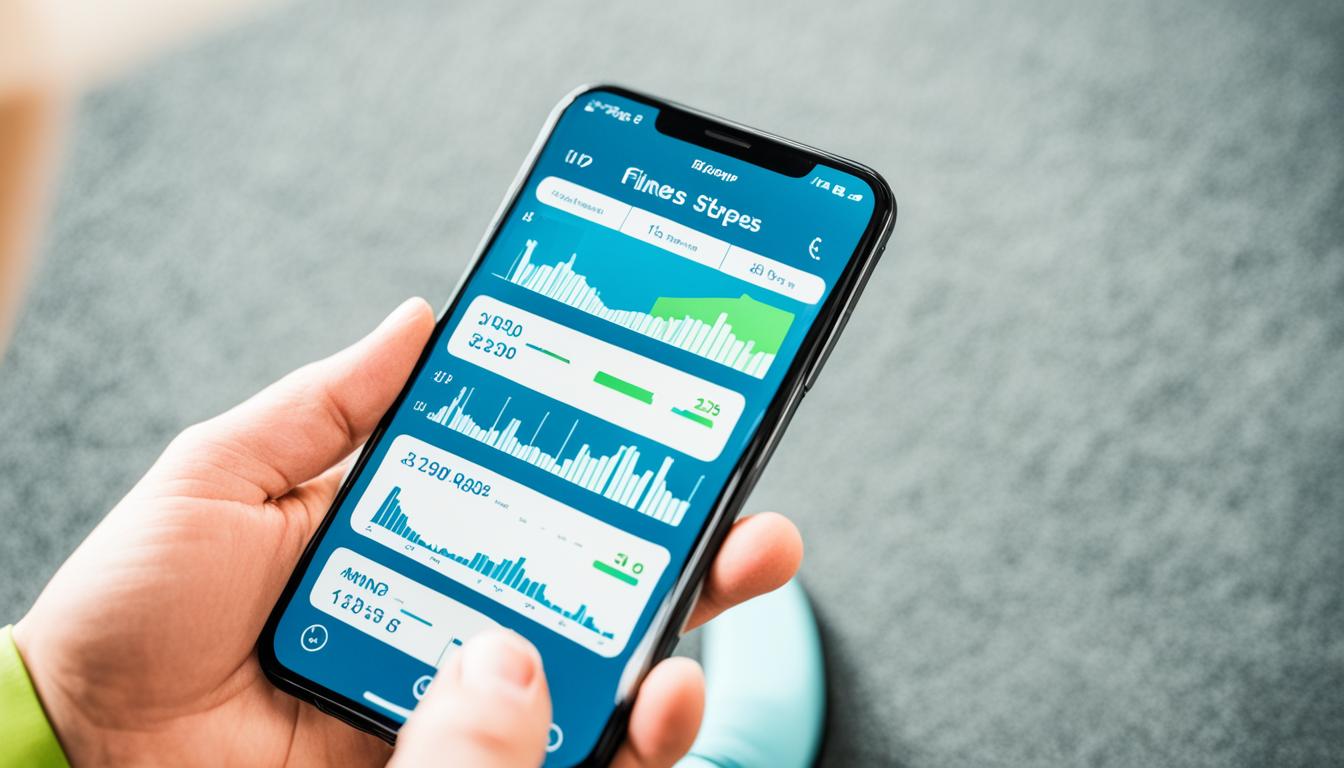
In today’s mobile-dependent world, optimizing smartphone internet use is essential to avoid excessive data charges. By monitoring data usage and setting limits, as well as leveraging Wi-Fi to minimize data consumption, you can enjoy a seamless online experience while staying within your data plan. It is also important to understand the impact of media downloads on your data allowance. Here are some strategies to help you optimize your smartphone internet use and avoid unexpected charges:
Monitoring Data Usage and Setting Limits
One of the key steps in optimizing your smartphone internet use is to monitor your data usage. Most smartphones have built-in tools that allow you to track your data consumption. By regularly checking your data usage, you can stay informed about your usage patterns and take necessary steps to avoid going over your data limit. Additionally, consider setting data usage limits or alerts on your device to receive notifications when you approach a certain threshold.
Tips for Using Wi-Fi to Minimize Data Consumption
Using Wi-Fi whenever available is an effective way to minimize data consumption on your smartphone. When connected to a Wi-Fi network, your device uses the internet provided by the network instead of consuming cellular data. To fully leverage Wi-Fi, ensure that you connect to secure and reliable networks, such as your home Wi-Fi or trusted public hotspots. Be cautious when connecting to open or unsecured networks, as they may pose security risks.
Here are some additional tips to minimize data consumption:
- Download large files and media content, such as apps, music, videos, and podcasts, while connected to Wi-Fi to avoid using your cellular data.
- Disable automatic app updates and downloads over cellular data in your device settings.
- Utilize offline modes in streaming apps to download content for offline viewing.
- Turn off background data for non-essential apps to prevent them from using data in the background.
Understanding the Impact of Media Downloads on Data Allowance
Media downloads, such as streaming music, videos, and high-resolution images, can significantly impact your data allowance. These downloads consume large amounts of data and can quickly deplete your monthly allocation. To mitigate the impact, consider adjusting the quality settings of your streaming apps to lower resolutions or enabling data-saving modes when available. Additionally, limit excessive media downloads and prioritize them for Wi-Fi use.
Optimizing smartphone internet use is crucial for avoiding excess data charges. By monitoring your data usage, using Wi-Fi whenever possible, and being mindful of media downloads, you can stay within your data limits and enjoy uninterrupted connectivity on your smartphone.
Comparing Mobile Networks: Coverage and Speed Considerations
When it comes to choosing the right mobile network for your smartphone internet connectivity, evaluating network coverage and speed is crucial. Comparison shopping allows you to make an informed decision that aligns with your needs and preferences.
Firstly, consider mobile network coverage. A network with wider coverage ensures that you have a reliable internet connection wherever you go. Research and compare the coverage maps of different mobile networks in your area to determine which provides the best coverage for your usual locations and travel destinations.
Alongside coverage, network speed is an essential factor to consider. Faster network speeds enable smoother streaming, faster downloads, and overall better performance. You can refer to online resources and customer reviews to get an idea of the average network speeds offered by different providers in your area.
Ultimately, finding the right mobile network involves striking a balance between coverage and speed. Consider your priorities and usage patterns. If you frequently travel or reside in areas with limited coverage, prioritizing a network with wider coverage is key. On the other hand, if you heavily rely on data-intensive tasks such as streaming or online gaming, prioritizing a network with faster speeds may be more beneficial. Take the time to compare and evaluate different mobile networks based on coverage and speed considerations, so you can make an informed decision that suits your specific needs.
Source Links
Are Smartphones Addictive? Uncover the Truth.
Smartphones have become an indispensable part of our daily lives, connecting us to a world of information, communication, and entertainment at our fingertips. But amidst the convenience and connectivity, a growing concern looms – are smartphones addictive?
In this article, we will delve deep into the subject of smartphone addiction and uncover the truth behind this phenomenon. By exploring the science, research, and real-life consequences of excessive smartphone use, we aim to shed light on whether smartphones truly hold an addictive power over us or if this belief is simply a myth.
Throughout this journey, we will examine the psychological, sociocultural, and neurological aspects of smartphone addiction to gain a comprehensive understanding of its potential risks and explore strategies for managing smartphone use. So, let’s dive in and separate fact from fiction in the world of smartphone addiction.
Key Takeaways:
- Smartphone addiction is a growing concern in today’s digital era.
- This article aims to uncover the truth behind smartphone addiction.
- We will explore the psychological, sociocultural, and neurological aspects of smartphone addiction.
- Understanding the potential risks of excessive smartphone use is crucial for managing smartphone addiction.
- Strategies for managing smartphone use and finding a healthy balance will be discussed in this article.
The Science of Smartphone Attachment
In this section, we will explore the science behind smartphone attachment and delve into the psychological and emotional factors that contribute to smartphone dependency. We will also differentiate between problematic use and addiction, outlining the behaviors and consequences associated with each.
Defining Problematic Use vs. Addiction
It is essential to distinguish between problematic smartphone use and addiction. Problematic use refers to excessive or uncontrolled smartphone usage that may interfere with daily functioning and have negative consequences. It may include behaviors such as constantly checking the device, neglecting responsibilities, and experiencing distress when unable to access the smartphone.
On the other hand, addiction involves a compulsive and uncontrollable need to use the smartphone, regardless of the negative impact on one’s life. It is characterized by an inability to cut back or stop smartphone use, withdrawal symptoms when attempting to do so, and a preoccupation with the device that disrupts relationships and activities.
Understanding the distinction between problematic use and addiction is crucial for identifying the level of intervention needed and providing appropriate support to individuals struggling with smartphone dependency.
Understanding Attachment and Separation Anxiety
Attachment theory, initially developed by John Bowlby, provides insights into the emotional bonds individuals form with their smartphones. Just as infants form attachments to their caregivers, individuals may develop a sense of attachment to their smartphones, considering them a source of comfort, connection, and security.
This attachment may lead to separation anxiety, where individuals experience distress or anxiety when they are away from their smartphones or unable to use them. The fear of missing out on social interactions, updates, or important information can contribute to this anxiety, intensifying the attachment and reinforcing smartphone dependency.
The concept of attachment and separation anxiety sheds light on the emotional and psychological factors that play a significant role in the development and maintenance of smartphone attachment and problematic use.
Table: Behaviors and Consequences Associated with Problematic Smartphone Use and Addiction
| Problematic Smartphone Use | Smartphone Addiction |
|---|---|
| Excessive checking of the device | Compulsive and uncontrollable need to use the smartphone |
| Neglect of responsibilities and obligations | Inability to cut back or stop smartphone use |
| Interference with relationships and activities | Withdrawal symptoms when attempting to reduce use |
| Distress when unable to access the smartphone | Preoccupation with the device |
By understanding the science of smartphone attachment, as well as the distinction between problematic use and addiction, we can gain valuable insights into the complexities of smartphone dependency. This knowledge can guide the development of effective strategies for managing smartphone use and promoting a healthier relationship with these devices.
Deep Dive into Smartphone Addiction Research
In this section, we will conduct a deep dive into the research surrounding smartphone addiction. By analyzing the methodologies and potential pitfalls of addiction studies, we can gain a better understanding of the strengths and limitations of current research on smartphone addiction. Furthermore, we will critically assess the diagnosis criteria for addiction to evaluate their applicability to smartphone addiction.
The field of smartphone addiction research is rapidly evolving, with numerous studies examining the psychological, sociological, and neurological aspects of this phenomenon. However, it is essential to approach the research with a critical eye, considering the various methodologies used and the potential bias or limitations that may impact the findings.
Methodologies and Pitfalls of Addiction Studies
One of the challenges in smartphone addiction research is the absence of standard methodologies across studies. Different research approaches, such as surveys, interviews, and laboratory experiments, are employed, which can lead to variations in results and difficulty in comparing findings. Additionally, many studies rely on self-reported data, which can be influenced by social desirability bias or inaccurate memory recall.
Another potential pitfall in addiction studies is the reliance on cross-sectional designs that capture a snapshot of data at a specific point in time. Longitudinal studies, which track participants over an extended period, can provide more insights into the development and progression of smartphone addiction. However, conducting longitudinal studies can be challenging due to time and resource constraints.
Analyzing the Diagnosis Criteria for Addiction
Diagnosing smartphone addiction is still a subject of debate among researchers and mental health professionals. The criteria used for diagnosing smartphone addiction are often adapted from existing frameworks for substance addictions or behavioral addictions, such as gambling disorder. However, it is crucial to consider the unique characteristics of smartphone use and the potential differences in addictive behaviors compared to substance or behavioral addictions.
A commonly used framework for diagnosing addiction is the DSM-5 (Diagnostic and Statistical Manual of Mental Disorders, Fifth Edition). However, the applicability of the DSM-5 criteria to smartphone addiction has been questioned due to the distinct nature of smartphone use and its integration into daily life activities. Some argue that a new diagnostic framework specifically tailored to smartphone addiction is needed to capture its unique aspects and consequences accurately.
By examining addiction studies’ methodologies and critiquing the diagnosis criteria for addiction, we can gain a more comprehensive understanding of smartphone addiction. This knowledge will contribute to the ongoing dialogue surrounding the definition, assessment, and treatment of smartphone addiction.
Assessing the Sociocultural Impact on Smartphone Usage

In the modern digital age, smartphones have become an integral part of our daily lives, enabling us to stay connected, access information, and engage with the world around us. However, the sociocultural impact of smartphone usage extends beyond mere convenience. This section will explore how sociocultural factors influence smartphone usage and shape our relationship with these devices.
Cultural Influences on Technology Use
Culture plays a significant role in shaping our attitudes and behaviors towards technology, including smartphones. Different cultures may have varying degrees of acceptance, usage patterns, and norms surrounding smartphone use. For example, in some cultures, smartphones are seen as essential tools for communication and social connection, while in others, they might be viewed as distractions or even symbols of status.
Cultural values, such as the importance of individuality, collectivism, or social harmony, can also influence how smartphones are used. These values may shape the types of apps and features preferred, the frequency and duration of smartphone use, and the balance between virtual and face-to-face interactions.
Furthermore, cultural beliefs and practices surrounding privacy, etiquette, and social norms can impact the ways in which individuals interact with their smartphones. For instance, some cultures may prioritize privacy and limit smartphone use in certain settings, such as during meals or in religious ceremonies.
By considering cultural influences on technology use, we can gain a deeper understanding of how society and individuals shape their smartphone behaviors.
Social Identity and Virtual Connections
Smartphones play a crucial role in the formation and maintenance of social identities, providing users with an avenue for self-expression and connection with like-minded individuals. Through social media platforms, messaging apps, and online communities, smartphones facilitate virtual connections that transcend geographical boundaries.
By curating online personas, individuals can construct and present their identities to the world, expressing their interests, values, and beliefs. These virtual connections offer opportunities for self-affirmation, validation, and social support, which are all essential for forming a sense of belonging and enhancing social identity.
However, the virtual nature of these connections can also have implications for smartphone addiction. Excessive reliance on virtual interactions may lead to a sense of isolation and detachment from real-world relationships, jeopardizing social and emotional well-being.
It is important to recognize the role of social identity and virtual connections in smartphone usage and strike a balance between online and offline social interactions.
The Psychological Grip of Smartphones
In today’s digital age, smartphones have become essential companions in our daily lives. But have you ever wondered why it’s so hard to put them down? This section will explore the psychological grip that smartphones have on us, shedding light on the role of dopamine and how social media platforms enhance addiction.
The Role of Dopamine in Smartphone Use
Dopamine, often referred to as the “feel-good” neurotransmitter, plays a crucial role in our brain’s reward system. When we engage in activities that bring us pleasure or reward, such as using our smartphones, dopamine is released, creating a sense of enjoyment and reinforcing the behavior.
Smartphone features like notifications, likes, and messages trigger dopamine release, making us feel good and encouraging us to seek further engagement. This reinforcement loop strengthens the psychological grip of smartphones and can lead to excessive use and addiction.
How Social Media Platforms Enhance Addiction
Social media platforms are designed to maximize user engagement and keep us coming back for more. They employ various psychological tactics that further enhance the addictive nature of smartphone use.
One example is the use of infinite scrolling, which creates an endless stream of content, feeding our need for novelty and making it difficult to disengage. Additionally, features like auto-play videos, notifications, and personalized algorithms cater to our individual preferences, increasing the likelihood of prolonged usage.
Moreover, social media platforms foster a sense of social validation through likes, comments, and followers, triggering dopamine release and creating a desire for more online interactions. This constant reinforcement and social stimulation contribute to the addictive grip of smartphones.
By understanding the role of dopamine and the design tactics employed by social media platforms, we can better recognize and address the psychological grip of smartphones. In the next section, we will explore the behavioral economics behind smartphone apps and their impact on addiction.
Understanding the Behavioral Economics Behind Apps

Smartphone apps have become an integral part of our daily lives, offering a wide range of functionalities and entertainment. But have you ever wondered why some apps are so addictive? This section will explore the behavioral economics behind smartphone apps and delve into the mechanisms that contribute to their impact on addiction.
The Science of Reward Prediction Errors
One of the key factors driving the addictive nature of smartphone apps is the science of reward prediction errors. In simple terms, our brains are wired to seek out rewards and avoid negative outcomes. When using apps, our brains make predictions about the rewards we will receive, such as social interaction, entertainment, or achievement. However, these predictions don’t always match reality, leading to reward prediction errors.
Research has shown that reward prediction errors can trigger a release of dopamine, a neurotransmitter associated with pleasure and motivation. When an app delivers a reward that is better than expected, dopamine levels spike, reinforcing the behavior and increasing the likelihood of continued app usage. This creates a cycle of anticipation, reward, and craving that keeps users engaged and hooked on their favorite apps.
Variable Reward Schedules and User Engagement
Another important aspect of behavioral economics in app design is the use of variable reward schedules. Rather than providing rewards at a fixed interval, apps often employ random or variable reward schedules. This technique, inspired by the principles of operant conditioning, maximizes user engagement and encourages addictive behaviors.
Variable reward schedules create an element of uncertainty and anticipation, making users more likely to keep using the app in the hope of receiving a reward. This can be seen in popular apps like social media platforms and mobile games, where users receive notifications, likes, or in-game rewards unpredictably. The unpredictability of these rewards makes them more enticing and reinforces the addictive nature of the app.
By understanding the behavioral economics behind apps, we can gain insight into the strategies used to keep us hooked. It’s important to be mindful of these techniques and develop healthy habits and boundaries to maintain a balanced and responsible approach to smartphone app usage.
Are smartphones addictive?
After exploring the science, research, and practical consequences of excessive smartphone use, we can now directly address the question of whether smartphones are addictive. This topic has been the subject of much debate, with strong arguments on both sides. However, drawing from the scientific evidence presented in earlier sections, we can provide a comprehensive answer.
Smartphones have undoubtedly become an integral part of our daily lives, offering convenience, connectivity, and opportunities for productivity. However, their addictive potential cannot be ignored. The design of smartphones, coupled with the captivating nature of apps and social media platforms, has created an environment that fosters addictive behaviors.
The omnipresence of smartphones and the constant connectivity they offer have led to a phenomenon known as “phantom vibration syndrome,” where individuals experience the perception of their phone vibrating in the absence of any notification. This physical and psychological response exemplifies the extent to which smartphones have become ingrained in our daily routines.
The addictive nature of smartphones is further intensified by the role of dopamine, a neurotransmitter associated with pleasure and reward. As we engage with our smartphones, activities such as receiving notifications, likes, or messages trigger dopamine release in the brain, reinforcing the addictive cycle.
Furthermore, social media platforms employ behavioral psychology techniques to enhance addiction. Through variable reward schedules, notifications, and the infinite scroll feature, these platforms stimulate our desire for more, creating an urge to constantly check our smartphones for updates and validation.
While smartphones themselves are not inherently addictive substances like drugs or alcohol, they can still elicit addictive behaviors and have a significant impact on our well-being. Excessive smartphone use has been linked to a range of negative consequences, including decreased productivity, impaired cognitive function, anxiety, depression, and sleep disturbances.
Despite the addictive nature of smartphones, it is essential to note that not everyone who uses smartphones will develop an addiction. Factors such as individual susceptibility, underlying mental health conditions, and the presence of coping mechanisms can influence one’s vulnerability to smartphone addiction.
As we continue to navigate the digital age, it is crucial to maintain a healthy and mindful relationship with our smartphones. By implementing strategies for managing smartphone use, setting boundaries, and seeking support when needed, we can strike a balance between utilizing the benefits of smartphones and mitigating their addictive potential.
Practical Consequences of Excessive Smartphone Use

In today’s digital age, excessive smartphone use has become a prevalent concern with practical consequences that affect both our mental and physical health. Understanding these consequences is essential for making informed decisions about our smartphone usage. This section will explore the effects on mental health, including anxiety and depression, as well as the physical health risks, such as eye strain and text neck.
Effects on Mental Health: Anxiety and Depression
Excessive smartphone use has been linked to negative mental health outcomes, particularly increased anxiety and depression. Constant engagement with social media, constant communication, and feelings of fear of missing out (FOMO) can contribute to heightened levels of anxiety.
Furthermore, the compulsive need to check notifications and constantly be connected can disrupt sleep patterns, leading to sleep deprivation, which is closely associated with depression. The dopamine rush from receiving notifications and the addictive nature of social media platforms can create a dependency that further exacerbates these mental health issues.
Physical Health Risks: Eye Strain and Text Neck
Besides the mental health effects, excessive smartphone use can also have physical health risks. One of the common physical consequences is eye strain or digital eye strain, which includes symptoms such as eye fatigue, dry eyes, and blurred vision. Staring at small screens for extended periods and the prolonged exposure to blue light emitted by smartphones can strain the eyes and lead to discomfort.
Another physical risk associated with excessive smartphone use is text neck. Text neck refers to the forward head posture and the strain on the neck and spine caused by constantly looking down at a smartphone. This can lead to chronic pain, muscle imbalances, and even spinal issues.
It is crucial to be aware of these practical consequences and strive for a healthy balance between smartphone usage and other aspects of life. By taking proactive measures to manage our smartphone use, such as setting designated screen-free times and practicing digital detoxes, we can mitigate the negative effects and improve our overall well-being.
Neurological Changes Induced by Smartphone Dependency
Excessive smartphone use has been found to have a significant impact on brain structure and function, leading to various neurological changes. Research has shown that prolonged smartphone dependency can alter the brain’s chemistry and wiring, resulting in potential long-term effects on cognitive abilities and neurological health.
One of the key findings in neurological studies is the association between smartphone use and decreased gray matter volume in certain brain regions. Gray matter is responsible for processing information, and its decline has been linked to decreased cognitive abilities, including memory, attention, and decision-making.
Moreover, excessive smartphone use has been shown to affect neurotransmitter systems in the brain, particularly dopamine. Dopamine is a neurotransmitter associated with pleasure and reward, and its dysregulation can lead to addictive behaviors. Smartphone dependency can disrupt the natural balance of dopamine in the brain, contributing to a cycle of craving and reinforcement.
“The constant stimulation we receive from our smartphones can alter our brain’s reward system, making us more susceptible to addiction,” says Dr. Thomas Johnson, a neuroscientist at Harvard Medical School.
Furthermore, prolonged smartphone use has been found to impact the brain’s connectivity and neural networks. Studies have shown alterations in the white matter integrity, which affects the efficiency of information transmission between brain regions. These changes in connectivity may contribute to deficits in cognitive functioning and emotional regulation.
Understanding the neurological changes induced by smartphone dependency is crucial for addressing the potential risks associated with excessive smartphone use. Further research is necessary to explore the long-term effects of smartphone addiction on brain health and to develop effective strategies for managing smartphone dependency.
Examining the Social Paradigm Shift Due to Smartphones

In today’s hyper-connected world, smartphones have ushered in a social paradigm shift, transforming the way we interact, communicate, and build relationships. The rise of smartphones and the proliferation of digital platforms have created a hyper-social digital environment, blurring the boundary between our online and offline lives.
Navigating Our Hyper-Social Digital Environment
In this hyper-social digital environment, social media platforms, messaging apps, and online communities have become integrated into our daily routines. We find ourselves constantly connected, scrolling through news feeds, liking and commenting on posts, and sharing our thoughts and experiences with a vast network of friends, acquaintances, and even strangers.
As we navigate this digital landscape, we are confronted with new challenges and complexities. The ease of access to information brings both advantages and disadvantages. It allows us to stay informed, connect with diverse perspectives, and engage in meaningful discussions. However, it also exposes us to misinformation, echo chambers, and the pressure to maintain a carefully curated online presence.
Moreover, the proliferation of smartphones has blurred the boundaries between work and personal life. With constant notifications and the expectation of responsiveness, we find it increasingly difficult to disconnect and find moments of solitude. Our attention is constantly divided, making it challenging to focus on deep, meaningful interactions.
Impacts on Interpersonal Relationships and Communication
The hyper-social digital environment created by smartphones has undoubtedly affected our interpersonal relationships and communication patterns. While smartphones enable us to stay connected with loved ones, regardless of geographical barriers, they also introduce new dynamics that can impact the quality of our relationships.
One of the key challenges is finding a balance between online and offline interactions. The constant connectivity offered by smartphones can lead to a decreased emphasis on face-to-face communication, with many conversations happening through screens rather than in person. This shift can affect the depth and authenticity of our relationships, as it may be harder to convey emotions and fully understand someone’s intentions through digital channels alone.
In addition, the hyper-social digital environment can also create feelings of comparison, envy, and social pressure. The highlight reels presented on social media can lead to unrealistic expectations and a sense of inadequacy, impacting our self-esteem and overall well-being. Moreover, the ability to easily access a wide network of people can sometimes lead to shallower connections and a decreased sense of community.
It’s important to note that while smartphones have brought about a social paradigm shift, they are a tool that can be used in both positive and negative ways. With conscious and mindful use, we can harness the benefits of smartphones and the hyper-social digital environment while preserving the depth and quality of our interpersonal relationships.
| Challenges in a Hyper-Social Digital Environment | Impact on Interpersonal Relationships and Communication |
|---|---|
| Constant connectivity and the pressure to always be online | Decreased emphasis on face-to-face communication |
| Information overload and the spread of misinformation | Shallower connections and decreased sense of community |
| Comparison, envy, and social pressure | Unrealistic expectations and decreased authenticity |
Smartphone Use: The Fine Line Between Utility and Overindulgence
Smartphones have undoubtedly become an integral part of our daily lives, offering a wide range of functionalities that enhance our productivity, communication, and entertainment. However, there is a fine line between utilizing smartphones for their intended purposes and overindulging in their constant connectivity. It is essential to strike a balance and be mindful of the potential drawbacks that come with excessive smartphone use.
Drawbacks of Constant Connectivity
Constant connectivity, while offering convenience, can have detrimental effects on our well-being and overall quality of life. The continuous stream of notifications, alerts, and messages can lead to feelings of overwhelm, distraction, and even anxiety. Our constant engagement with our smartphones can make it difficult to disconnect and find moments of true relaxation and mental clarity. Additionally, the temptation to check our phones incessantly can hinder our ability to focus on important tasks, impacting our productivity and overall performance.
Cognitive Changes in Smartphone-Heavy Users
Research suggests that excessive smartphone use can lead to cognitive changes. The constant engagement with smartphones and the multitasking nature of smartphone activities can impair our ability to concentrate and retain information. Moreover, studies have shown that heavy smartphone users may experience a decline in memory and problem-solving skills. The constant stimulation provided by smartphones, combined with the fragmented attention it requires, can significantly impact our cognitive abilities over time.
To illustrate the cognitive changes induced by smartphone-heavy usage, a study conducted by researchers at the University of Texas at Austin found that the presence of smartphones, even when unused, can reduce cognitive capacity. The study participants who had their phones in another room performed significantly better on cognitive tasks compared to those who had their phones within reach. This indicates the potential cognitive consequences of constant smartphone connectivity.
It is important to be aware of these cognitive changes and consider the effects of smartphone use on our mental capabilities. By recognizing the potential risks and consequences, we can make conscious decisions about our smartphone usage and prioritize our cognitive well-being.
Regulatory and Industry Perspective on Smartphone Use

In order to address concerns regarding smartphone addiction, both regulatory bodies and industry stakeholders have taken steps to promote responsible smartphone use. These efforts aim to protect users and ensure that smartphones are used in a safe and healthy manner.
Regulatory bodies have recognized the need to establish guidelines and regulations to mitigate the risks associated with excessive smartphone use. They have implemented policies that aim to raise awareness about smartphone addiction and provide support for individuals struggling with this issue.
Industry stakeholders, on the other hand, have made significant efforts to develop features and tools that encourage responsible smartphone use. Smartphone manufacturers, app developers, and social media platforms have implemented strategies such as screen time monitoring, app usage limits, and digital well-being initiatives. These measures aim to empower users to manage their smartphone use effectively and maintain a healthy balance.
Through collaboration between regulatory bodies and industry stakeholders, the goal is to create a regulatory environment that promotes responsible smartphone use while still allowing individuals to enjoy the benefits of smartphone technology.
“It is important for regulations and industry practices to strike a balance between protecting users from addiction and preserving the freedom to use smartphones for their intended purposes.”
By considering the regulatory and industry perspectives on smartphone use, individuals can make informed decisions about their smartphone habits and take advantage of the resources available to manage smartphone addiction effectively.
Strategies for Managing Smartphone Use and Potential Addiction
Psychological Interventions and Behavioral Therapy
To effectively manage smartphone use and potential addiction, psychological interventions and behavioral therapy techniques can be highly beneficial. These approaches aim to address the underlying psychological factors and behavioral patterns associated with smartphone addiction.
Psychological interventions, such as cognitive-behavioral therapy (CBT), can help individuals develop healthier habits and coping mechanisms to reduce smartphone dependency. CBT focuses on identifying and challenging negative thoughts, emotions, and behaviors related to smartphone use. By working with a therapist, individuals can gain insight into their triggers and develop strategies to manage problematic smartphone behaviors.
Behavioral therapy techniques, such as setting goals and rewards, can also be effective in modifying smartphone use patterns. By creating a structured plan and setting achievable goals for reducing screen time, individuals can gradually decrease their reliance on smartphones. Rewarding oneself for meeting these goals can provide additional motivation and reinforcement to maintain healthy smartphone habits.
Creating Healthy Digital Boundaries
In addition to psychological interventions and therapy, creating healthy digital boundaries is essential for managing smartphone use and preventing addiction. Here are some practical tips:
- Set specific time limits for smartphone use each day
- Designate device-free zones or periods, such as during meals or before bed
- Turn off non-essential notifications to minimize distractions
- Practice mindful smartphone usage by being fully present in the moment
- Engage in alternative activities, such as hobbies or exercise, to reduce reliance on smartphones
- Establish healthy sleep routines by avoiding smartphone use before bedtime
By implementing these strategies, individuals can regain control over their smartphone use, minimize the risk of addiction, and maintain a healthy balance in their digital lives.
Source Links
Smartphones & Societal Issues: Uncovering Links
Did you know that the average person spends over 3 hours on their smartphone every day? That’s more than 1,000 hours a year! The impact of smartphones on society cannot be overstated, as they have become an integral part of our daily lives, affecting everything from our communication to our mental health. In this article, we will delve into the complex relationship between smartphones and societal issues, exploring the negative consequences of excessive smartphone use and its wide-ranging implications. Join us as we uncover the links between smartphones and the challenges they pose to our well-being and society as a whole.
Introduction to the Pervasiveness of Smartphones in Modern Society
In today’s rapidly evolving digital landscape, smartphones have become an integral part of our daily lives. From communication and entertainment to productivity and convenience, these devices have revolutionized the way we interact with the world around us. In this section, we will delve into the rise of smartphone usage across demographics, the transformation of smartphones from luxury items to ubiquitous necessities, and the core functions that have made them indispensable in shaping societal norms and behaviors.
The Psychological Impacts of Smartphones on Communication

In today’s digital age, smartphones have become an integral part of our lives, transforming the way we communicate with one another. However, their widespread use has also given rise to various psychological impacts on our interpersonal interactions and communication skills.
Alterations in Interpersonal Interactions and Conversational Depth
Smartphones have significantly altered the landscape of interpersonal interactions. With the constant presence of smartphones, face-to-face conversations have taken a backseat, as people are more engrossed in their digital devices. This shift in communication dynamics has led to a decline in conversational depth and genuine engagement with others.
Instead of deep, meaningful conversations and connections, interactions have become fragmented and superficial. The constant distractions and interruptions from smartphone notifications hinder our ability to fully engage in conversations and understand subtle nonverbal cues. As a result, the quality of communication has suffered, impacting our ability to form and maintain meaningful relationships.
Smartphones and the Decline of Face-to-Face Communication Skills
The overreliance on smartphones has also led to a decline in face-to-face communication skills. As more interactions occur through screens and keyboards, the art of effective face-to-face communication is gradually eroding. Skills such as active listening, maintaining eye contact, and interpreting body language are becoming less practiced and valued.
Furthermore, the convenience of smartphone communication has resulted in decreased motivation to engage in face-to-face conversations. People may prefer the ease of sending a text message or instant message, rather than having a real-time conversation. This shift in communication preferences can hinder our ability to develop essential social skills and navigate complex social dynamics effectively.
| Psychological Impacts of Smartphones on Communication | |
|---|---|
| Alterations in Interpersonal Interactions | Decline in Face-to-Face Communication Skills |
| – Fragmented and superficial conversations | – Decreased motivation for face-to-face conversations |
| – Lack of genuine engagement and understanding | – Erosion of essential social skills |
| – Impact on relationship building |
How could smartphones be linked to societal problems
Smartphones have become an indispensable part of our daily lives, shaping how we communicate, work, and navigate the world. While these devices offer convenience and connectivity, they are not without their consequences. The widespread use of smartphones has raised concerns about their potential impact on society and the various societal problems that may arise as a result.
One of the primary consequences of excessive smartphone usage is the negative impact on mental health. Research suggests that excessive screen time and social media usage can contribute to feelings of anxiety, depression, and loneliness. The constant exposure to curated online content and the pressure to maintain a certain online image can exacerbate these issues, leading to detrimental effects on individual well-being.
Moreover, smartphones have been linked to a decline in face-to-face communication skills, which are essential for building meaningful relationships and fostering social cohesion. With the rise of smartphone dependency, individuals may prefer online interactions over in-person connections, resulting in a reduced ability to develop and maintain interpersonal relationships.
Another societal problem associated with smartphones is the impact on productivity and work-life balance. The constant availability and accessibility of smartphones can blur the boundaries between personal and professional life, leading to increased stress and burnout. Additionally, the distraction and time spent on smartphone activities can hinder productivity, affecting overall work performance.
Furthermore, smartphones have contributed to an increase in distracted driving incidents, posing a significant risk to road safety. The temptation to use smartphones while driving has resulted in accidents, injuries, and even fatalities. This highlights the need for increased awareness and responsible smartphone usage to ensure the safety of individuals on the road.
By understanding these consequences of smartphone usage on society, we can begin to address the challenges they pose. Initiatives promoting digital well-being, such as setting boundaries for smartphone use and fostering mindful usage, can help mitigate the negative effects. Additionally, raising awareness about the potential societal problems associated with excessive smartphone usage can encourage individuals to adopt healthier habits and find a balance between technology and human interaction.
Exploring Privacy Concerns and Data Security in the Smartphone Era

In this section, we will delve into the privacy concerns and data security issues associated with smartphones in the digital era. As our reliance on smartphones continues to grow, so do our concerns about the safety and privacy of our personal information.
Rising Threats to Personal Privacy on Mobile Platforms
Smartphones have become a treasure trove of personal data, from our contacts and messages to our browsing history and location information. Unfortunately, this wealth of data also makes smartphones an attractive target for cybercriminals and hackers.
The rise of mobile platforms has brought about an increase in privacy breaches, exposing users to various threats such as data breaches, identity theft, and unauthorized access to personal information. With more and more apps requesting permission to access our personal data, it is essential to be vigilant about protecting our privacy.
Data breaches have become all too common, with even major companies falling victim to cyberattacks. The consequences of these breaches can be severe, leading to financial loss, reputational damage, and emotional distress for the individuals affected.
How Smartphones Contribute to Data Vulnerability
Smartphones are designed to be convenient and connected, allowing us to access a wealth of information and services at our fingertips. However, this convenience comes at a cost in terms of data vulnerability.
Many smartphone apps collect and store vast amounts of personal data, including our contacts, location, browsing habits, and even biometric information. While this data can enhance the functionality and personalization of our smartphones, it also increases the risk of data breaches and unauthorized access.
In addition, the always-on nature of smartphones means that our devices are constantly transmitting and receiving data, creating opportunities for interception and data theft. Public Wi-Fi networks, which are commonly used with smartphones, can be particularly vulnerable to man-in-the-middle attacks and other security breaches.
To mitigate these risks, it is crucial to take steps to enhance data security on our smartphones. This includes regularly updating our devices with the latest security patches, using strong and unique passwords, and being cautious about the apps we install and the permissions we grant.
| Steps to Enhance Data Security on Smartphones | |
|---|---|
| 1. Regularly update your device software | Keep your smartphone’s operating system and applications up to date to ensure you have the latest security patches. |
| 2. Use strong and unique passwords | Use a combination of letters, numbers, and special characters for your device and app passwords. Avoid using common passwords or reusing passwords across multiple accounts. |
| 3. Be cautious about app permissions | Review the permissions requested by apps before granting access to your personal data. Only give permissions that are necessary for the app’s intended functionality. |
| 4. Install antivirus and security apps | Consider installing reputable antivirus and security apps on your smartphone to protect against malware, phishing attempts, and other security threats. |
| 5. Use secure Wi-Fi networks | Avoid connecting to public Wi-Fi networks when transmitting sensitive data. If you must connect to public Wi-Fi, use a virtual private network (VPN) to encrypt your connection. |
Social Media’s Influence on Youth and the Role of Smartphones
In today’s digital age, social media has significantly influenced the behavior of young individuals, with smartphones playing a crucial role in facilitating this influence. The addictive nature of social media platforms and excessive smartphone usage among teenagers has raised concerns regarding their psychological well-being and societal impact.
Link between Smartphone Addiction and Social Media Usage in Teens
Studies have shown a strong correlation between smartphone addiction and the excessive use of social media platforms among teenagers. The constant need to stay connected and receive validation through likes, comments, and shares can lead to addictive behaviors and increased smartphone dependency. The widespread availability of smartphones and the easy access to social media platforms have amplified this phenomenon, with detrimental consequences on the overall well-being of young individuals.
The Psychological Consequences of Constant Digital Connection
The constant digital connection enabled by smartphones and social media has profound psychological consequences on youth behavior. Excessive use of social media can contribute to feelings of anxiety, depression, and low self-esteem, as young individuals compare their lives to the carefully curated highlight reels of others. Additionally, the continuous exposure to cyberbullying and online harassment can further exacerbate these psychological issues, posing a significant threat to the mental health of young individuals.
To illustrate this complex relationship between social media, smartphone addiction, and youth behavior, consider the following statistics:
| Statistic | Percentage |
|---|---|
| Teens who use social media for more than five hours per day | 32% |
| Teens experiencing symptoms of depression due to social media use | 27% |
| Teens who have been cyberbullied | 20% |
These statistics highlight the significant impact of social media on youth behavior and the urgency to address the psychological consequences of constant digital connection.
The Ecological Footprint of Smartphone Production and Disposal

In today’s society, smartphones have become an indispensable part of our lives. However, the environmental impact of smartphone production and disposal is often overlooked. In this section, we will delve into the ecological footprint of smartphone manufacturing and explore sustainable alternatives that can mitigate environmental hazards.
Environmental Hazards of Smartphone Manufacturing Processes
Smartphone production involves complex manufacturing processes that contribute to environmental hazards. From the extraction of raw materials to the assembly of components, each stage of the manufacturing process has its own environmental impact. For instance, the mining of minerals such as cobalt and lithium, used in smartphone batteries, often leads to deforestation, soil degradation, and water pollution. Additionally, the energy-intensive production methods and the generation of electronic waste further exacerbate environmental concerns.
According to a study by Greenpeace, the production of one smartphone generates an estimated 85 kilograms of carbon dioxide emissions. This is equivalent to the emissions produced by driving a car for 200 kilometers.
Furthermore, the improper disposal of smartphones poses a significant threat to the environment. E-waste, which includes discarded electronic devices like smartphones, contains toxic substances such as lead, mercury, and cadmium. When these substances leach into soil and water, they can contaminate ecosystems and harm both human and animal health.
Exploring Sustainable Alternatives to Current Industry Practices
The smartphone industry is starting to recognize the importance of sustainable practices and is taking steps to mitigate its environmental impact. One example is the incorporation of recycled materials into smartphone manufacturing, reducing the reliance on newly extracted resources. In addition, eco-friendly packaging and energy-efficient production processes are being implemented to minimize waste and energy consumption.
Moreover, consumer awareness and demand for sustainably produced smartphones are driving companies to adopt more environmentally friendly practices. Brands such as Fairphone are pioneering sustainable smartphone manufacturing by focusing on ethical sourcing, repairability, and longevity. By designing smartphones that are easy to repair and upgrade, they aim to extend the lifespan of devices and reduce electronic waste.
Government regulations and industry standards also play a crucial role in promoting sustainable smartphone production and disposal. Policy initiatives, such as extended producer responsibility, can hold manufacturers accountable for the end-of-life management of their products. Additionally, recycling programs and facilities can incentivize consumers to properly dispose of their old smartphones, facilitating the recycling and recovery of valuable materials.
By embracing sustainable alternatives and promoting responsible consumption and disposal, we can reduce the ecological footprint of smartphone production and contribute to a more environmentally conscious future.
Smartphones as a Tool for Reinforcing Social Inequalities
In today’s digital age, smartphones have become an integral part of our daily lives, with their impact reaching far beyond personal communication and entertainment. While smartphones have the potential to bridge gaps and connect people across different socioeconomic backgrounds, they can also inadvertently reinforce social inequalities. In this section, we will explore how smartphones contribute to social disparities and the barriers they create in terms of access to technology, education, and opportunities.
Access to Technology as a Measure of Socioeconomic Status
Access to smartphones and other digital devices has become a defining factor in determining one’s socioeconomic status. In many societies, having a smartphone is not merely a luxury but a necessity, enabling individuals to stay connected, access information, and participate in the digital world. However, not everyone has equal access to technology, creating a digital divide that disproportionately affects those from marginalized communities or low-income backgrounds.
The cost of smartphones, along with the ongoing expenses of data plans and internet access, can pose significant financial barriers for individuals and families who are already struggling to meet their basic needs. As a result, access to vital resources and opportunities that are increasingly reliant on digital platforms, such as job applications, educational resources, and social connections, are limited for those who cannot afford smartphones or access to reliable internet services.
Smartphones and the Digital Divide in Education and Opportunity
The digital divide extends beyond access to smartphones; it also encompasses disparities in digital literacy and the quality of education and opportunities available to different groups. As educational institutions increasingly integrate technology into their curricula, students without access to smartphones or reliable internet may face limitations in their learning experiences. This further perpetuates existing educational inequalities, hindering the academic progress and future prospects of marginalized students.
Furthermore, smartphones have become a gateway to various economic opportunities and platforms, such as remote work, freelance gigs, and online marketplaces. However, individuals without access to smartphones are often excluded from these opportunities, further widening the gap between socioeconomic classes.
It is imperative that efforts are made to bridge the digital divide and ensure equal access to technology, education, and opportunities for all members of society. By doing so, we can create a more inclusive and equitable society where smartphones serve as tools for empowerment rather than reinforcing social inequalities.
Mitigating Smartphone Distractions and Promoting Mindful Usage

Smartphones have become an integral part of our daily lives, providing us with constant connectivity and access to information. However, this reliance on digital devices can lead to distractions and hinder our ability to be present and engaged in the moment. To counteract this overreliance and cultivate a greater sense of presence, it is important to adopt strategies for mindful smartphone usage.
Strategies for Counteracting Overreliance on Digital Devices
Here are some effective strategies to help you reduce smartphone distractions:
- Create device-free zones: Designate specific areas or times in your daily routine where smartphones are not permitted. This can include meal times, family gatherings, or bedtime.
- Set boundaries: Establish clear rules and limits for smartphone usage, such as turning off notifications during work or designated relaxation times. Stick to these boundaries to create a healthier relationship with your device.
- Practice digital detox: Take regular breaks from your smartphone by setting aside dedicated periods of time without any digital distractions. Use this time to engage in activities that promote mindfulness, such as reading, meditating, or spending time in nature.
- Use productivity apps: Utilize smartphone apps that can help manage your screen time and promote focus. These apps can limit access to certain apps or websites during specific hours, helping you stay productive and minimize distractions.
- Engage in offline activities: Find hobbies and activities that do not require smartphone usage. This could include exercising, pursuing creative outlets like painting or playing musical instruments, or spending quality time with loved ones.
Techniques for Cultivating Presence and Authentic Engagement
In addition to counteracting overreliance, it is important to cultivate presence and authentic engagement in our interactions with smartphones. Here are some techniques to help you achieve this:
- Practice mindful smartphone usage: Before reaching for your phone, pause and ask yourself if the action is necessary and aligned with your current intentions. This simple act of mindfulness can help you become more aware of your smartphone habits.
- Practice active listening: When engaging in conversations or interacting with others, put your phone aside and give them your full attention. Actively listen and show genuine interest in what they are saying, fostering deeper connections and meaningful conversations.
- Engage in single-tasking: Instead of multitasking and constantly switching between different apps or activities, focus on one task at a time. This allows you to fully immerse yourself in the present moment and give your undivided attention to the task at hand.
- Cultivate gratitude: Take a moment each day to reflect on the positive aspects of your life that do not involve smartphones. Express gratitude for meaningful relationships, nature, or moments of solitude that allow for reflection and self-discovery.
By implementing these strategies and techniques, you can develop a healthier and more mindful relationship with your smartphone. Remember, the goal is not to completely disconnect from technology, but rather to create a balanced approach that allows you to be present and engaged in the world around you.
Smartphones and Emotional Health: Understanding the Connection

In today’s digital age, smartphones have become an integral part of our lives, impacting various aspects of our well-being, including our emotional health. As we rely more on technology, it is essential to acknowledge and understand the connection between smartphones and our emotional equilibrium.
Identifying Symptoms of Technology-Induced Stress and Anxiety
The pervasive use of smartphones can contribute to technology-induced stress and anxiety. Excessive screen time, constant notifications, and the pressure to stay connected can overwhelm and impact our mental well-being. Symptoms of technology-induced stress and anxiety may include:
- Feelings of restlessness and irritability
- Inability to relax or disconnect from digital devices
- Trouble focusing or concentrating
- Sleep disturbances and insomnia
- Increased levels of tension and unease
Recognizing these symptoms is crucial in addressing the negative impact of smartphones on our emotional health.
The Quest for Emotional Equilibrium in the Digital Age
In our quest for emotional equilibrium, it is essential to navigate the digital landscape mindfully. Developing strategies to promote a healthier relationship with our smartphones can help us maintain emotional well-being in the digital age.
Some strategies to consider include:
- Setting boundaries for screen time and establishing designated technology-free zones.
- Practicing self-care activities that promote relaxation and stress relief, such as meditation, exercise, or spending time in nature.
- Engaging in face-to-face interactions and strengthening relationships beyond digital platforms.
- Limiting exposure to social media and cultivating a healthy online presence.
By prioritizing our emotional well-being and adopting mindful smartphone usage habits, we can strive for a healthier balance between technology and our emotions.
The Role of Smartphones in Globalization and Cultural Exchange

In today’s interconnected world, smartphones play a vital role in fostering international connectivity and cross-cultural understanding. With their ability to connect people across borders and provide instant access to information, smartphones have become powerful tools for driving globalization and promoting cultural exchange.
Smartphones have revolutionized the way we communicate and interact with others, breaking down barriers and creating opportunities for cultural exchange. Through social media platforms, messaging apps, and video calls, individuals from different parts of the world can connect in real-time and share their experiences, traditions, and perspectives. This constant exchange of ideas and cultural practices has the potential to enrich our understanding of diverse cultures, fostering empathy and appreciation for global diversity.
However, it’s important to recognize that the impact of smartphones on cultural exchange is a double-edged sword. While smartphones facilitate the exchange of ideas, they also pose risks of cultural homogenization. As people around the world adopt similar technological habits and consume similar content, there is a concern that cultural diversity could be diluted, resulting in a loss of traditional practices and values.
The challenge lies in finding a balance between embracing the global connectivity that smartphones offer and preserving cultural diversity. This requires us to actively seek out and celebrate diverse voices, cultures, and perspectives while using smartphones as a tool for fostering understanding and empathy.
Fostering International Connectivity and Cross-Cultural Understanding
The widespread availability of smartphones has made it easier than ever to connect with individuals from different countries and cultures. Through social media platforms, individuals can engage in discussions, follow global events, and share their stories and experiences. This constant flow of information and communication breaks down geographical barriers, fostering international connectivity and promoting cross-cultural understanding.
The Double-Edged Sword of Cultural Homogenization
While smartphones enable us to connect with diverse cultures, there is a risk of cultural homogenization. As people consume content that is easily accessible through smartphones, there is a tendency for cultural practices, traditions, and values to converge. This could lead to a loss of cultural diversity and an erosion of unique cultural identities. It is crucial to actively promote and preserve cultural diversity while leveraging smartphones for global connectivity.
Designing a Future Where Technology and Humanity Coexist

In today’s rapidly evolving technological landscape, it is crucial to envision a future where technology and humanity can coexist harmoniously. As smartphones continue to play an integral role in our daily lives, it is essential to set boundaries for healthy technology consumption and prepare future generations for ethical smartphone use. By doing so, we can ensure that technology remains a tool for progress and well-being rather than a source of societal issues.
Setting Boundaries for Healthy Technology Consumption
A key aspect of designing a future with technology is establishing boundaries to promote healthy technology consumption. As smartphones become increasingly integrated into our lives, it is vital to find a balance between utilizing their capabilities and avoiding excessive usage. Encouraging individuals to engage in regular digital detoxes, prioritize face-to-face interactions, and establish designated screen-free times can help cultivate a healthier relationship with technology.
Preparing Future Generations for Ethical Smartphone Use
As we look to the future, it is essential to equip future generations with the knowledge and skills necessary for ethical smartphone use. This includes educating young individuals about the potential risks associated with excessive smartphone use, such as mental health issues and privacy concerns. By fostering digital literacy, promoting responsible online behavior, and teaching critical thinking skills, we can empower individuals to navigate the digital world responsibly and ethically.
Shaping Policy and Community Norms around Smartphone Usage
As smartphones have become an integral part of our daily lives, it is crucial to shape policies and community norms around their usage. Governmental regulation plays a vital role in ensuring ethical practices in smartphone distribution. By implementing guidelines and standards, governments can protect consumers from potential risks associated with smartphone usage, such as privacy breaches and data vulnerabilities.
Governmental Regulation and the Ethics of Smartphone Distribution
Governmental bodies have a responsibility to regulate the smartphone industry and ensure that smartphones are distributed ethically. This includes aspects such as fair labor practices, responsible sourcing of materials, and environmentally sustainable manufacturing processes. By establishing stringent regulations, governments can encourage smartphone manufacturers to prioritize ethical practices throughout the supply chain, promoting social and environmental responsibility.
Community Initiatives to Curb Smartphone Dependency
Alongside governmental regulation, community initiatives play a crucial role in curbing smartphone dependency. Community organizations, schools, and parents can collaborate to raise awareness about healthy smartphone usage and promote responsible digital citizenship. These initiatives can include educational programs, workshops, and support groups that focus on developing mindful and balanced smartphone habits. By fostering a community-driven approach, we can address the challenges of smartphone dependency together, creating a more harmonious relationship between individuals and their devices.
Ultimately, shaping policies and community norms around smartphone usage is imperative for us to create a healthier and more balanced relationship with smartphones. With effective governmental regulation and community-driven initiatives, we can ensure the ethical distribution of smartphones and promote responsible usage practices. By working together, we can harness the benefits of smartphones while mitigating the potential negative impacts on individuals, communities, and society as a whole.
Source Links
Smartphones History Timeline – Key Milestones
Did you know that there are currently more than 3.8 billion smartphone users worldwide? That’s nearly half of the global population!
Smartphones have transformed the way we live, communicate, and work. To understand the evolution of these devices, let’s explore the key milestones in the history of smartphones. From the inception of mobile communication to the revolutionary advancements in cellular networks, the rise of touchscreen innovation, and the advent of 5G, this timeline takes us through the significant moments that shaped the smartphone industry.
Key Takeaways:
- The number of smartphone users worldwide has exceeded 3.8 billion.
- Smartphones have had a profound impact on various aspects of our lives.
- The history of smartphones is marked by significant milestones and innovations.
- From mobile communication to 5G networks, smartphones have continuously evolved.
- Exploring the timeline of smartphones can provide valuable insights into their development and future possibilities.
The Inception of Mobile Communication: Pre-Smartphone Era
Before smartphones became an integral part of our lives, mobile communication had its early beginnings. In this section, we’ll explore the pre-smartphone era and the origins of mobile phones. From the first working prototype in 1973 to the approval of the first mobile phone in 1983, we’ll delve into the early stages of mobile communication and the technological advancements that laid the foundation for the future of smartphones.
During the pre-smartphone era, mobile phones were bulky and primarily focused on voice communication. The first working prototype, known as the Motorola DynaTAC 8000X, was developed in 1973 by Martin Cooper and his team at Motorola. This prototype laid the groundwork for future advancements in cell phone technology.
In 1983, the first commercial mobile phone, the Motorola DynaTAC 8000X, was approved by the FCC (Federal Communications Commission). This milestone marked the beginning of widespread mobile phone usage, albeit limited to a select number of users.
While these early mobile phones lacked the advanced features and capabilities of modern smartphones, they played a crucial role in shaping the future of mobile communication. The pre-smartphone era set the stage for the development of more compact, feature-rich devices that we now rely on for various aspects of our daily lives.
Next, let’s explore the revolutionary beginnings of mobile phones with Motorola’s groundbreaking entry and the launch of the first mobile phone in the next section.
Revolutionary Beginnings: Motorola and the First Mobile Phone
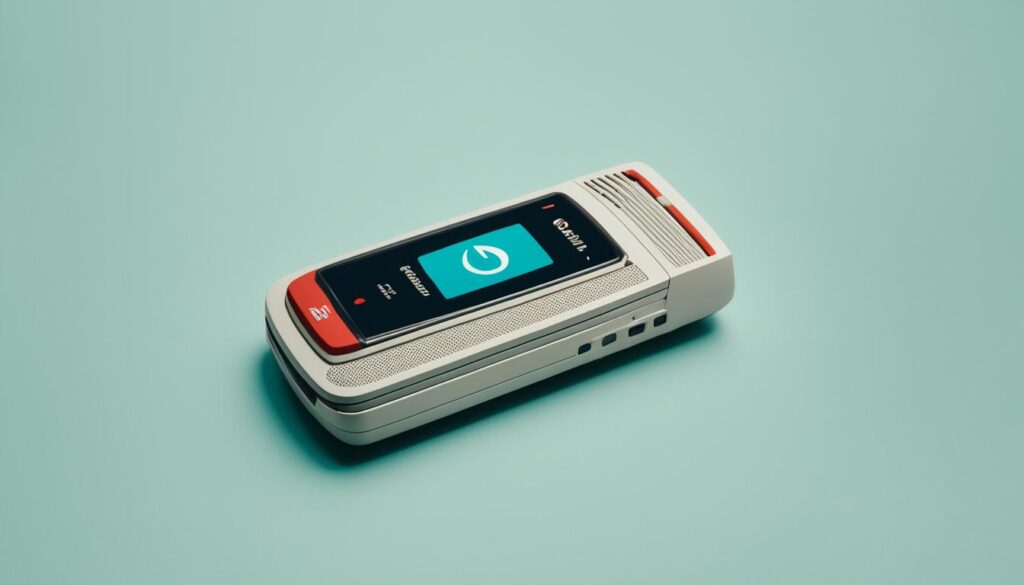
In the early development of mobile phones, Motorola played a pivotal role in shaping the industry. One of the key milestones in cell phone development was the launch of the first commercial mobile phone by Motorola in 1983. This groundbreaking device, known as the Motorola DynaTAC 8000X, marked the beginning of a new era in mobile communication.
The DynaTAC 8000X, affectionately referred to as the “brick” due to its size and weight, was an impressive feat of engineering for its time. It featured a sleek design with a long antenna and a large numeric keypad, allowing users to easily dial phone numbers. The phone’s display, although basic by modern standards, provided clear and legible characters.
Despite its hefty price tag of $3,995 (equivalent to over $10,000 in today’s currency), the DynaTAC 8000X was met with enthusiasm from consumers who were eager to embrace this cutting-edge technology. It offered a remarkable 30 minutes of talk time and a standby time of up to 8 hours, revolutionizing the way people communicated and stayed connected.
With the release of the DynaTAC 8000X, Motorola set the stage for further advancements in mobile phone technology. This device paved the way for smaller, more portable phones with enhanced features and capabilities. Motorola’s contribution to the development of the first mobile phone laid the foundation for the future of cell phones and set the industry on a trajectory of innovation and progress.
Motorola DynaTAC 8000X Specifications:
| Feature | Specification |
|---|---|
| Launch Year | 1983 |
| Dimensions | 13 x 1.75 x 3.5 in |
| Weight | 2.2 lbs |
| Battery Life | 30 minutes talk time, 8 hours standby |
| Network Compatibility | AMPS (Advanced Mobile Phone System) |
| Price | $3,995 |
From 1G to 2G: The Evolution of Cellular Networks
As mobile communication continued to advance, the evolution of cellular networks played a crucial role in enhancing the capabilities of smartphones. The transition from 1G to 2G marked a significant milestone in the historical progression of these networks.
The Launch of 1G and Ameritech’s Contribution
In the early 1980s, the first generation of cellular networks, commonly known as 1G, was introduced. Ameritech, one of the Regional Bell Operating Companies (RBOCs), played a vital role in the development and deployment of 1G technology. Their efforts led to the establishment of the first commercial cellular network in the United States in 1983. This network paved the way for mobile communication to become widely accessible and transformed the way people communicate on the go.
Transition to 2G: Advancements in Mobile Communications
The transition from 1G to 2G signaled a significant advancement in mobile communications. The introduction of 2G networks brought about several improvements, including better call quality, enhanced security features, and the ability to send text messages. This shift also paved the way for the integration of digital services and data transmission in mobile devices.
The advancements in 2G technology enabled more efficient use of the available radio frequencies, leading to increased capacity and improved network performance. This allowed users to experience faster and more reliable connections, enabling them to browse the internet, send emails, and access basic multimedia content on their smartphones.
Lithium-Ion Batteries: Powering the Next Generation of Cellular Devices
Another crucial development that accompanied the transition from 1G to 2G was the adoption of lithium-ion batteries in cellular devices. These advanced batteries provided higher energy density, longer lifespan, and better performance compared to their predecessors. Their introduction revolutionized the power capabilities of smartphones, allowing for extended usage and reduced downtime for charging.
The integration of lithium-ion batteries in mobile devices played a vital role in facilitating the growth and widespread adoption of smartphones. With longer battery life, users could rely on their devices for extended periods, making smartphones an indispensable tool in their daily lives.
| 1G | 2G |
|---|---|
| First generation of cellular networks | Second generation of cellular networks |
| Introduced in the early 1980s | Transitioned in the early 1990s |
| Analog technology | Digital technology |
| Provides basic voice calls | Enables data transmission and text messaging |
| Lower capacity and slower data transfer | Higher capacity and improved network performance |
The Dawn of Smartphones: IBM’s Groundbreaking Entry
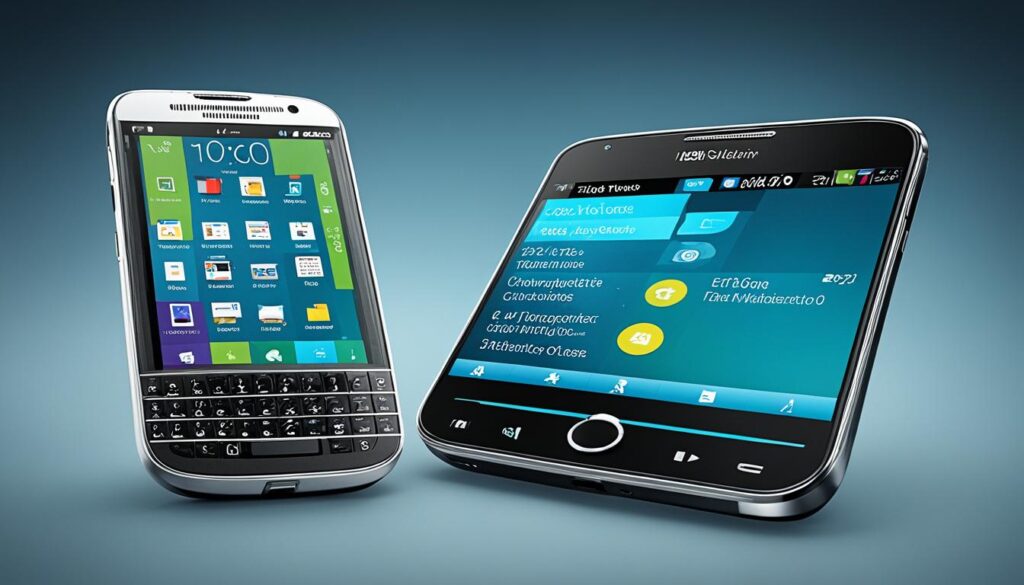
In this section, we’ll delve into the dawn of smartphones with IBM’s groundbreaking entry into the market. We’ll explore the prototype created by IBM engineer Frank Canova in 1992, which is considered the first true smartphone. We’ll discuss its features, its impact on the industry, and its eventual release to consumers.
Text Messaging and the Birth of Mobile Connectivity
Mobile connectivity took a significant leap with the introduction of text messaging. In 1992, the first text message was sent, forever changing the way we communicate using mobile devices. This innovation allowed people to send short, written messages to one another, creating a new form of instant communication.
Text messaging, also known as SMS (Short Message Service), quickly gained popularity and became an integral part of mobile phones. It enabled users to send and receive messages, making communication faster and more convenient. Whether it was sharing important information, planning meetups, or simply staying in touch, text messaging revolutionized mobile connectivity.
The ease and simplicity of text messaging made it a preferred mode of communication for people around the world. This new form of mobile connectivity transcended geographical borders and time zones, bringing people closer together.
With the birth of text messaging, mobile devices became more than just phones. They became personal communication tools that allowed individuals to stay connected, even when they were on the move.
Today, text messaging continues to play a vital role in our lives. From personal conversations to business communications, text messaging remains a reliable and efficient way to connect with others. It has evolved to include multimedia messages, group chats, and even business marketing campaigns.
As we reflect on the history of mobile phones, it is clear that text messaging was a pivotal moment in the development of mobile connectivity. Its impact can still be felt today, as we rely on text messaging to stay connected in our fast-paced, mobile-driven world.
Smartphones History Timeline: The Swift Progression Through the ’90s
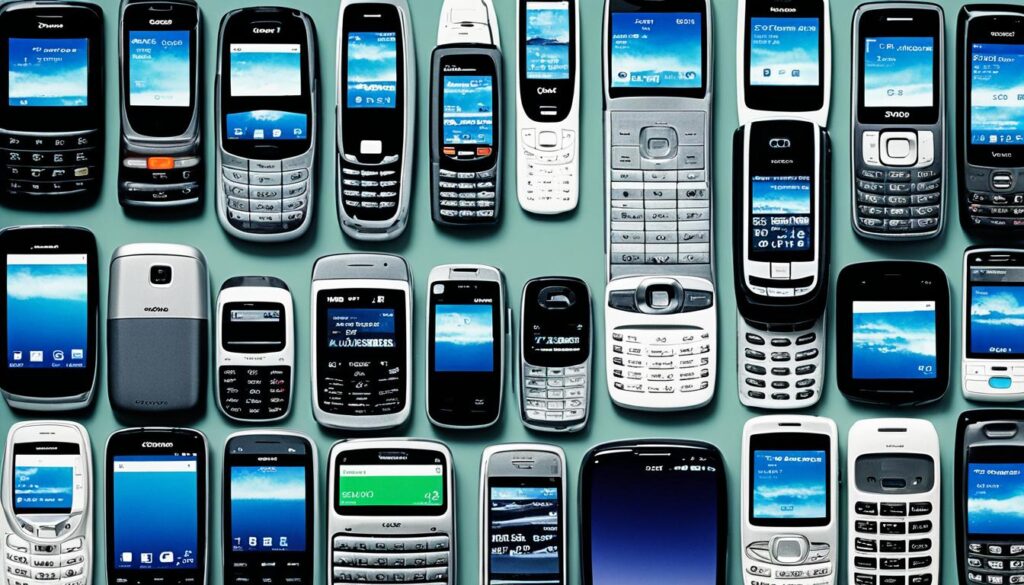
The 1990s marked a period of rapid development in the history of smartphones. In this section, we will explore two key aspects of this era that played a significant role in shaping the smartphone industry.
Ericsson’s Concept and the Coined Term “Smartphone”
During the ’90s, Ericsson paved the way for smartphone innovation with its groundbreaking concept. The company introduced the concept of a “smartphone,” a mobile device that combined the functionality of a cellular phone with advanced computing capabilities. This concept laid the foundation for the future of smartphones, leading to the convergence of communication and computing technologies.
“The introduction of the smartphone concept by Ericsson in the ’90s marked a turning point in the history of mobile devices. It sparked a new wave of innovation and set the stage for the smartphones we use today.”
Furthermore, Ericsson’s concept contributed to the popularization of the term “smartphone.” This coined term became widely recognized and used to refer to mobile phones with advanced features, capabilities, and connectivity beyond traditional cell phones.
The Advent of Mobile Gaming with Nokia’s Snake
In addition to Ericsson’s concept, the ’90s witnessed a significant milestone in the history of smartphones with the advent of mobile gaming. Nokia’s iconic game, Snake, captured the imagination of millions and revolutionized mobile entertainment.
“Nokia’s Snake game introduced a new era of mobile gaming, captivating users and demonstrating the potential of smartphones as entertainment devices. It set the stage for the vast array of gaming experiences that smartphones offer today.”
Snake, a simple yet addictive game, showcased the capabilities of smartphones beyond communication. Its popularity led to the development of more sophisticated mobile games and opened up new possibilities for entertainment on the go.
| Year | Key Milestones |
|---|---|
| 1990 | Introduction of Ericsson’s smartphone concept |
| 1992 | Debut of Nokia’s Snake game |
The Millennium’s Tech Boom: Camera Phones and 3G Introductions
The turn of the millennium brought significant advancements to smartphones. In this section, we’ll focus on the introduction of camera phones and the launch of 3G networks.
Camera phones revolutionized photography by allowing users to capture moments on the go. The first front-facing camera phone, the Kyocera VP-210, was released in 1999, enabling individuals to take self-portraits and engage in video calls. This innovation marked a new era in communication and self-expression.
With the commercial availability of camera phones, smartphones became more than just communication devices. People could now capture and share memories effortlessly, making photography a ubiquitous part of everyday life.
Simultaneously, the launch of 3G networks brought faster mobile internet speeds, transforming how we access information and communicate online. The 3G network allowed users to browse the internet, send emails, and stream media, expanding the possibilities of what a smartphone could offer.
Touchscreen Innovation and the Rise of iPhone’s Dominance
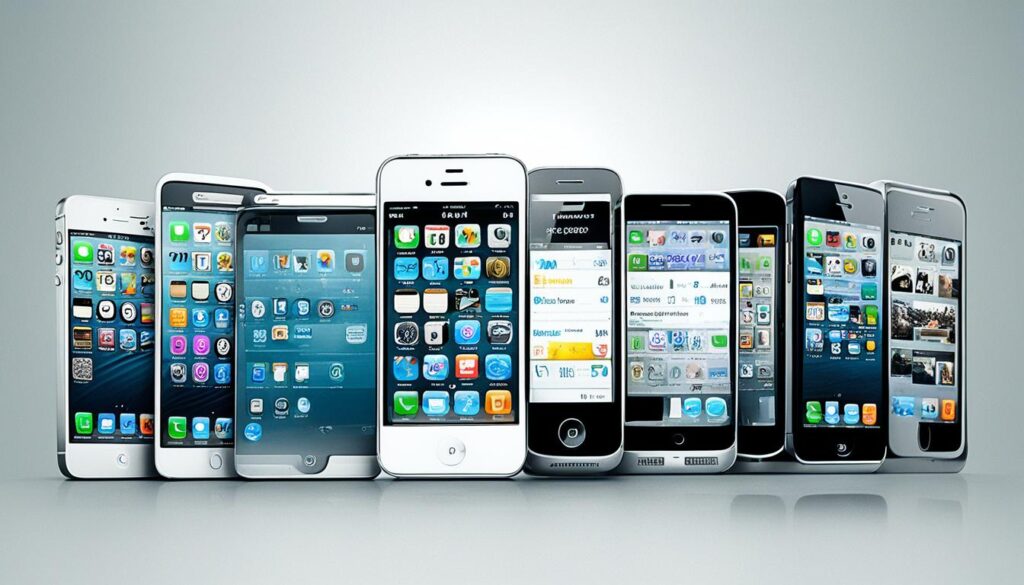
Touchscreen innovation revolutionized the smartphone industry. The introduction of touchscreens as the primary method of interaction with smartphones brought about a major shift in user experience and opened up new possibilities for functionality.
One of the key players in driving this innovation was Apple with its iconic iPhone. Launched in 2007, the iPhone quickly rose to dominance and set the standard for touchscreen smartphones. With its intuitive interface and multi-touch capabilities, the iPhone transformed the way people interacted with their devices, making it easier to navigate, browse the web, and perform various tasks.
The rise of the iPhone also spurred competition among other smartphone manufacturers, leading to further advancements in touchscreen technology. Companies such as Samsung, Google, and LG followed suit by integrating touchscreens into their devices, pushing the boundaries of what was possible with this innovative interface.
Today, touchscreen smartphones have become the norm, with nearly all smartphones featuring this technology. From simple taps and swipes to complex gestures and fingerprint recognition, touchscreens have become an integral part of our daily lives, enabling us to communicate, work, and entertain ourselves on the go.
The combined efforts of touchscreen innovation and the rise of the iPhone have not only revolutionized the smartphone industry but also paved the way for other touchscreen devices like tablets and smartwatches. As technology continues to evolve, we can expect further advancements in touchscreens, enhancing our interaction with these devices and driving new possibilities in the future.
Android Joins the Smartphone Arena: A New Era of Open-Source OS
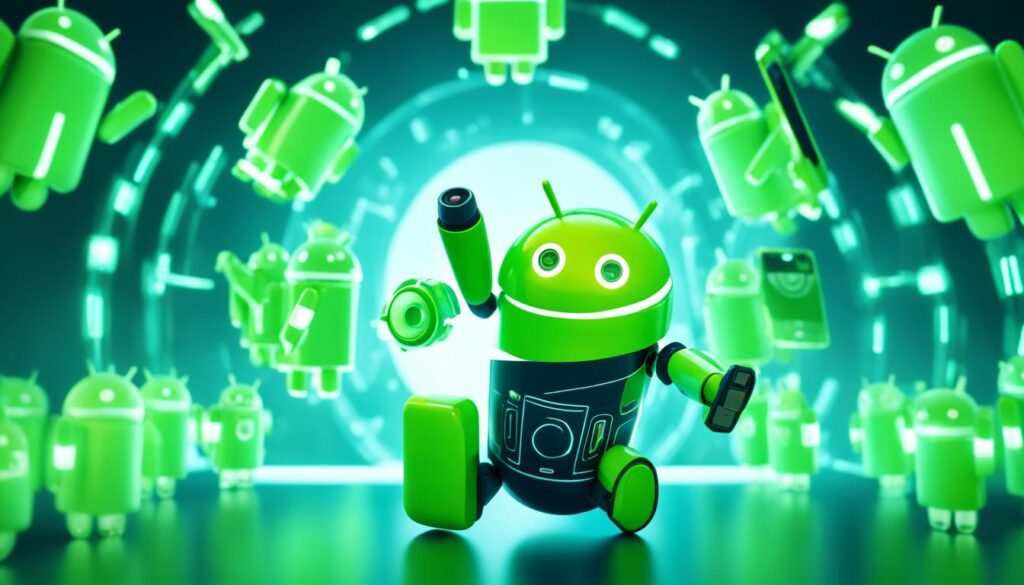
In the rapidly evolving world of smartphones, the entry of Android brought about a new era of open-source operating systems. With its debut in the early 2000s, Android quickly gained popularity and revolutionized the smartphone industry.
The Debut of the HTC Dream/T-Mobile G1
One of the key milestones in Android’s journey was the release of the HTC Dream, also known as the T-Mobile G1, in 2008. This groundbreaking device marked the first Android-powered mobile phone to hit the market. With its innovative features and user-friendly interface, the HTC Dream/T-Mobile G1 set the stage for the Android revolution.
The Significance of Google’s Android 1.0 Release
Accompanying the HTC Dream/T-Mobile G1 launch was the release of Google’s Android 1.0 operating system. This marked a significant milestone as it introduced an open-source OS to the smartphone market, enabling developers to create custom applications and making Android devices highly adaptable to user preferences. The release of Android 1.0 laid the foundation for the future of Android and its continuous growth in the smartphone industry.
| Key Points |
|---|
| The HTC Dream/T-Mobile G1 was the first Android-powered mobile phone. |
| Google’s Android 1.0 introduced an open-source OS to the smartphone market. |
| Android’s entry brought about a new era of highly customizable mobile devices. |
| The HTC Dream/T-Mobile G1 and Android 1.0 set the stage for Android’s rapid growth and popularity. |
4G Networks and the Surge of Mobile Internet Speeds

The introduction of 4G networks marked a significant leap in mobile internet speeds. With 4G, users experienced faster data transmission, enabling seamless streaming, rapid downloads, and enhanced browsing capabilities. This advancement revolutionized the way we connect and interact with the digital world on our smartphones and other mobile devices.
4G networks offered download speeds that were several times faster than their predecessors, providing a more efficient and enjoyable user experience. Tasks that were once time-consuming, such as downloading large files, streaming high-definition videos, and online gaming, became effortless and instantaneous.
The surge of mobile internet speeds brought numerous benefits to both individuals and businesses. Users could stay connected wherever they went, accessing information, communicating in real-time, and utilizing a wide range of mobile apps that depend on high-speed internet connectivity.
Businesses also capitalized on the opportunities presented by 4G networks. With faster mobile internet speeds, companies could enhance their online presence, develop innovative mobile applications, and provide seamless customer experiences. Industries such as e-commerce, media, transportation, and healthcare witnessed significant transformations, fueling economic growth and technological advancements.
Furthermore, the surge of mobile internet speeds paved the way for emerging technologies such as video streaming services, remote work and collaboration tools, and the Internet of Things (IoT). These developments revolutionized various aspects of our lives, from entertainment and communication to healthcare and transportation.
The impact of 4G networks on mobile connectivity cannot be overstated. As we continue to rely on smartphones and other mobile devices, it is crucial to acknowledge and appreciate the advancements brought about by 4G networks in shaping our digitally connected world.
The Advent of 5G and the Future of Connectivity

The advent of 5G networks promises to revolutionize connectivity. With its faster speeds, lower latency, and increased capacity, 5G has the potential to enable innovative technologies and transform various industries. This section will explore the introduction of 5G and its implications for the future of connectivity.
5G networks are expected to provide significantly faster download and upload speeds compared to previous generations. This means that tasks that currently take minutes, such as downloading large files or streaming high-quality videos, can be completed in a matter of seconds. The increased speed and lower latency of 5G will also enhance real-time applications such as video conferencing, online gaming, and virtual reality experiences.
Furthermore, 5G technology has the potential to support the massive growth of Internet of Things (IoT) devices. With its low latency and ability to connect a large number of devices simultaneously, 5G networks will enable seamless communication between devices, paving the way for more advanced smart homes, smart cities, and interconnected systems.
One of the most exciting prospects of 5G is its impact on autonomous vehicles. The high-speed, low-latency connectivity provided by 5G networks will enable real-time communication between vehicles, infrastructure, and pedestrians, creating safer and more efficient transportation systems. With reduced latency, autonomous vehicles will be able to make split-second decisions based on real-time data, revolutionizing the way we travel.
5G also has the potential to revolutionize industries such as healthcare, manufacturing, and entertainment. In healthcare, the high-speed connectivity of 5G will enable remote surgeries, real-time patient monitoring, and enhanced telemedicine capabilities. In manufacturing, 5G networks will facilitate seamless communication between machines, leading to increased efficiency and productivity. And in the entertainment industry, 5G will enable immersive experiences such as augmented reality and virtual reality on a mass scale.
“The advent of 5G networks marks a new era of connectivity, where faster speeds and lower latency will unlock endless possibilities for innovation and technological advancement.”
In summary, the advent of 5G networks holds tremendous potential for the future of connectivity. With its faster speeds, lower latency, and ability to support a massive number of devices, 5G will enable groundbreaking technologies and transform various industries. As we embrace the era of 5G, we can look forward to a more connected, intelligent, and innovative future.
Text Message Marketing: Transforming Business Communications
The Rise of Personalized SMS Campaigns
Text message marketing has revolutionized the way businesses communicate with their customers. Through personalized SMS campaigns, businesses can deliver targeted and relevant messages directly to their audience’s smartphones. This level of personalization allows companies to engage customers on a one-to-one basis, enhancing the effectiveness of their marketing efforts.
With personalized SMS campaigns, businesses can segment their customer base and tailor messages based on demographics, purchasing history, or specific interests. By sending personalized offers, recommendations, or event updates, businesses can create a more meaningful connection with their customers, increasing response rates and driving conversions.
Embracing Two-way Communication for Business Growth
In addition to personalized SMS campaigns, businesses are now embracing two-way communication to foster better relationships with their customers. By providing a channel for customers to easily respond, ask questions, or provide feedback via text messages, businesses can create a more interactive and customer-centric experience.
Two-way communication allows businesses to address customer inquiries promptly, provide real-time support, and gather valuable insights that can inform their product development or marketing strategies. By engaging in meaningful conversations with their customers, businesses can build trust, loyalty, and ultimately drive business growth.
Source Links
Who Started Smartphones? The Pioneers Revealed.
Smartphones have become an indispensable part of our modern lives. From communication and productivity to entertainment and navigation, these powerful devices have revolutionized the way we live and interact with technology. But have you ever wondered who started smartphones? Who were the visionaries behind this groundbreaking invention? In this article, we will delve into the origins of smartphones and reveal the pioneers who played a significant role in their development.
Join us on a journey through history as we uncover the fascinating stories of the smartphone inventors, the companies that led the revolution, and the technological advancements that reshaped the mobile industry. Discover the origins of the term ‘smartphone’ and explore the impact of early operating systems. We’ll also delve into the transformative impact of Apple’s iPhone and Google’s Android, as well as the role of app stores in smartphone adoption.
As we unravel the history of smartphones, we’ll also examine their profound impact on society, exploring how these devices have transformed communication, productivity, and various aspects of our everyday lives. And finally, we’ll look to the future and explore the next wave of smartphone innovations that promise to redefine the way we interact with technology.
Key Takeaways
- The origins of smartphones can be traced back to visionary inventors who had a vision for a new category of devices.
- IBM Simon, Nokia, and Research In Motion (BlackBerry) were among the companies that played a major role in starting the smartphone revolution.
- Symbian OS, Windows Mobile, and Palm OS were some of the early operating systems that powered smartphones.
- Apple’s iPhone redefined the concept of a smartphone, popularizing touchscreens and introducing the iOS ecosystem.
- Google’s Android democratized smartphone technology by providing an open-source operating system.
- App stores, such as the Apple App Store and Google Play Store, played a pivotal role in smartphone adoption.
- Smartphones have had a profound impact on society, transforming communication, productivity, and various aspects of everyday life.
- The future of smartphones holds potential advancements in foldable screens, 5G connectivity, and the integration of artificial intelligence and machine learning.
The Dawn of the Smartphone Era
In the early days of the smartphone era, a new category of devices emerged, thanks to the visionary minds of individuals who saw the potential for revolutionary mobile technology. These pioneers paved the way for the development of smartphones as we know them today.
The First Visionaries
Among the early visionaries who recognized the transformative power of smartphones was Martin Cooper, an engineer at Motorola. Cooper made history in 1973 when he placed the first-ever call from a handheld mobile phone. His invention laid the foundation for the future of mobile communication, inspiring other innovators to push the boundaries of what a phone could do.
A New Category of Devices
Building on the work of pioneers like Cooper, companies such as IBM and Nokia stepped forward to turn the concept of smartphones into reality. IBM’s launch of the Simon Personal Communicator in 1994 marked a significant milestone in the smartphone journey. It was the first device to combine mobile phone capabilities with other functionalities like email, fax, and calendar. This breakthrough device set the stage for the rapid evolution of smartphone technology.
Nokia, too, played a pivotal role in shaping the early smartphone landscape. With the introduction of devices like the Nokia 9000 Communicator in 1996, the company established itself as a leader in the smartphone market. These early smartphones offered a wide range of features, including internet connectivity and productivity tools, further expanding the possibilities of mobile communication.
The efforts of these visionaries and their commitment to pushing the boundaries of mobile technology laid the foundation for the smartphone revolution that would fundamentally transform the way we communicate, work, and live.
Invention of the Term ‘Smartphone’
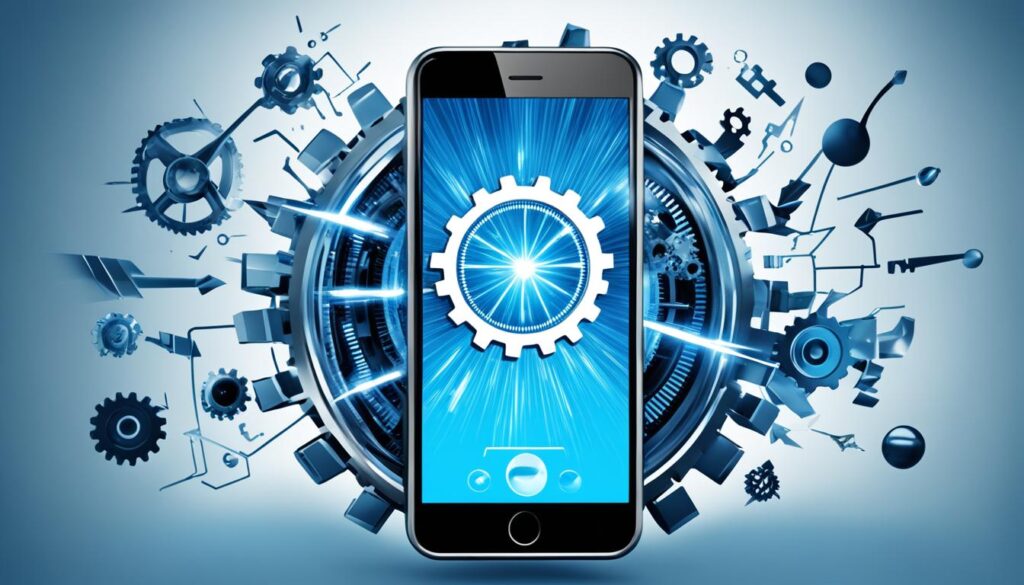
In the realm of mobile technology, the term ‘smartphone’ holds significant importance. But have you ever wondered where this term originated from? In this section, we will explore the origins of the term ‘smartphone’ and shed light on the individual who coined it.
When it comes to the invention of the smartphone term, there isn’t a singular individual credited with its creation. Rather, it emerged from the collective understanding of the evolving mobile phone industry and the amalgamation of various technological advancements.
During the early 2000s, as feature phones began incorporating more advanced capabilities such as email, web browsing, and productivity applications, the need to categorize these devices arose. The term ‘smartphone’ gained popularity as it encapsulated the idea of a phone that possessed enhanced capabilities beyond traditional voice communication.
“The smartphone is not just a phone but a pocket-sized computer capable of connecting to the internet and running various applications. It represents a paradigm shift in mobile communication and redefines our relationship with technology.” – Unknown
While there is no singular person who can be credited with coining the term ‘smartphone,’ it can be attributed to the collective efforts of multiple visionaries who contributed to the development and evolution of mobile technology. These visionaries envisioned a future where mobile phones would become more than just communication devices, propelling the industry forward.
| Year | Milestone |
|---|---|
| 1992 | Nokia introduces the first phone with a graphical user interface, the Nokia 1011. |
| 1993 | IBM unveils the Simon Personal Communicator, often considered the first smartphone due to its advanced features. |
| 1996 | Palm releases the PalmPilot, a handheld computer that popularizes personal digital assistants (PDAs) |
These early adopters contributed to the foundation of what we now know as smartphones. The term ‘smartphone’ became a common part of our vocabulary, representing a class of devices that have changed the way we communicate, work, and interact with the world around us.
With the invention of the smartphone term, a new era of mobile technology was born. The term served as a catalyst for the rapid evolution of these devices, setting the stage for the innovations and advancements that followed.
Who Started Smartphones: The Companies Behind the Revolution
In the early days of the smartphone revolution, several companies played pivotal roles in shaping the landscape of mobile communication. These companies drove innovation, introduced groundbreaking technologies, and ushered in a new era of smartphone devices.
IBM Simon: The First Smartphone?
One of the remarkable pioneers in the smartphone industry is IBM Simon. Released in 1994, the IBM Simon is widely considered the first true smartphone. It featured a touchscreen display, email capabilities, and even a built-in calendar. Although it was not as advanced as the smartphones we use today, the IBM Simon laid the foundation for future technological advancements.
The Rise of Nokia
Nokia, a Finnish company, also played a major role in the early years of the smartphone revolution. With its iconic models like the Nokia 9000 Communicator, Nokia brought innovation and functionality to the market. The Nokia 9000 Communicator, released in 1996, combined the features of a mobile phone and a personal digital assistant, setting the stage for the future of smartphones.
Research In Motion (BlackBerry) Leads the Market
An influential player in the smartphone revolution, Research In Motion (now known as BlackBerry) dominated the market for many years. The BlackBerry devices, with their physical keyboards and secure messaging capabilities, gained immense popularity among professionals and business users. They offered convenient email access and BBM (BlackBerry Messenger), revolutionizing the way people communicated on the go.
The contributions of these companies, including IBM Simon, Nokia, and Research In Motion (BlackBerry), laid the foundation for the smartphone revolution. They paved the way for the advancements we see in modern smartphones today, where companies continue to push boundaries and redefine the way we connect and interact with technology.
Operating Systems that Powered Early Smartphones

Early smartphones would not have been possible without the development of advanced operating systems that could handle the complex tasks required by these devices. In this section, we will explore three significant operating systems that played a crucial role in shaping the smartphone landscape: Symbian OS, Windows Mobile, and Palm OS.
Symbian OS: Opening the Doors
Symbian OS, developed by Symbian Ltd., was one of the first operating systems specifically designed for smartphones. It gained popularity in the early 2000s and became the dominant operating system for mobile devices worldwide. With its robust features and capabilities, Symbian OS enabled users to perform tasks such as web browsing, email management, and multimedia playback.
One of the notable features of Symbian OS was its support for third-party applications, which allowed developers to create and distribute software for smartphones. This opened the doors to a wide range of applications and enhanced the functionality of early smartphones.
Despite its initial success, Symbian OS faced increasing competition from other operating systems and eventually declined in popularity. However, its legacy can still be seen in the development of modern smartphone platforms.
Windows Mobile and Palm OS
Windows Mobile, developed by Microsoft, and Palm OS, developed by Palm, Inc., were two other significant operating systems that powered early smartphones.
Windows Mobile offered a familiar user interface, similar to that of Windows computers, which appealed to users already accustomed to Microsoft’s software ecosystem. It featured a wide range of applications and offered seamless integration with Microsoft Office and other productivity tools.
Palm OS, on the other hand, was known for its simplicity and ease of use. It provided a user-friendly interface and focused on intuitive navigation and organization of contacts, calendars, and other essential information. Palm OS devices, notably the Palm Pilot, gained popularity among professionals and became synonymous with personal digital assistants (PDAs).
Both Windows Mobile and Palm OS contributed to the early smartphone market, but with the rapid advancements in technology and the emergence of new players in the industry, their market shares declined over time.
Apple’s iPhone: Redefining the Smartphone
In this section, we will explore the revolutionary impact of Apple’s iPhone on the smartphone industry. The iPhone not only redefined the concept of a smartphone but also paved the way for a new era of mobile communication.
The Touchscreen Revolution
The introduction of the iPhone brought about a touchscreen revolution in the smartphone world. Unlike traditional phones with physical keyboards and buttons, the iPhone featured a large, capacitive touchscreen that revolutionized the way we interact with our devices. It allowed for intuitive gestures, such as swiping and pinching, making it easier and more seamless to navigate through apps, websites, and multimedia content.
iOS: A New Ecosystem Emerges
Alongside the groundbreaking hardware, Apple also introduced the iOS operating system, which further solidified the iPhone’s impact on the smartphone market. The iOS ecosystem offered a seamless user experience with a rich selection of apps, advanced security features, and regular software updates. It quickly became a benchmark for other smartphone platforms, setting new standards for performance, reliability, and user satisfaction.
Furthermore, Apple’s App Store provided a platform for developers to create and distribute innovative third-party apps, enhancing the functionality and versatility of the iPhone. This not only expanded the capabilities of the device but also opened up new avenues for businesses and individuals to connect, engage, and entertain through mobile applications.
| Apple’s iPhone Impact: | |
|---|---|
| Redefinition of the smartphone concept | – |
| Popularization of touchscreen technology | – |
| Introduction of the iOS operating system | – |
| Creation of a thriving app ecosystem | – |
| Setting new standards for performance and user experience | – |
Google’s Android: Democratizing Smartphone Technology

This section explores the impact of Google’s Android on the smartphone industry. It discusses how Android democratized smartphone technology by providing an open-source operating system and empowering a wide range of manufacturers to produce Android devices.
The rise of Google’s Android OS marked a significant milestone in the history of smartphones. With the introduction of Android, the smartphone market experienced a transformative shift towards openness and accessibility. Unlike proprietary operating systems, Android was open-source, providing developers with the freedom to customize and innovate.
This democratization of smartphone technology allowed a diverse array of manufacturers, from established industry players to emerging brands, to adopt Android as their operating system of choice. This resulted in an explosion of Android-powered devices, driving competition and choice in the market.
The impact of Android’s democratization can be seen in the increasing affordability and availability of smartphones. The wide range of Android devices caters to different price points and user needs, making smartphones accessible to a broader demographic.
Furthermore, Android’s open nature fostered a vibrant ecosystem of apps and services, thanks to the Google Play Store. Developers were able to create an extensive range of applications, providing users with a rich and diverse experience on their Android devices.
In addition, Android’s compatibility with a variety of hardware configurations ensured that manufacturers could innovate and experiment, pushing the boundaries of smartphone design and functionality.
Overall, Google’s Android OS played a pivotal role in democratizing smartphone technology, making it more accessible, affordable, and inclusive. Its open-source nature and widespread adoption have had a lasting impact on the smartphone industry, shaping the way we use and interact with our devices.
The Role of App Stores in Smartphone Adoption
In today’s mobile-driven world, app stores play a crucial role in the widespread adoption of smartphones. These digital marketplaces serve as convenient platforms for users to discover, download, and update applications tailored to their needs, enhancing the overall smartphone experience. Among the most influential app stores are the Apple App Store and the Google Play Store, each contributing to the rapid growth and evolution of the smartphone industry.
The App Store: Apple’s Game-Changer
The Apple App Store, launched in 2008, revolutionized the way users interacted with their iPhones. With its curated selection of innovative and diverse applications, the App Store transformed the iPhone into a versatile tool capable of catering to various interests and demands. The introduction of the App Store also paved the way for developers to showcase their creations, fostering a vibrant ecosystem of apps that continue to shape our digital lives. Today, the Apple App Store remains a cornerstone of smartphone app distribution, offering millions of apps to iPhone users worldwide.
Google Play Store Levels the Playing Field
Google’s response to the Apple App Store came in the form of the Google Play Store. Launched in 2012, the Play Store provided Android users with a vast selection of applications and games, expanding accessibility and choice beyond the iOS ecosystem. The Google Play Store enabled a multitude of smartphone manufacturers to embrace the Android operating system, fueling the proliferation of affordable, feature-rich devices. With its open and inclusive approach, the Play Store democratized app distribution, empowering developers worldwide to reach a broader audience.
| App Store | Launch Year | Key Features |
|---|---|---|
| Apple App Store | 2008 | Curated selection, innovation, vibrant ecosystem |
| Google Play Store | 2012 | Wide selection, affordability, openness |
Smartphones and Their Impact on Society

Smartphones have had a profound impact on society, revolutionizing the way we communicate, work, and live. The widespread adoption of smartphones has transformed the way people connect with each other, breaking down barriers of distance and enabling instant communication.
With smartphones, individuals can stay connected to friends, family, and colleagues through various communication apps, social media platforms, and messaging services. This constant connectivity has reshaped the way we maintain relationships, allowing for real-time interactions and quick exchanges of information.
Furthermore, smartphones have enhanced productivity by providing access to a wealth of information and tools right at our fingertips. Gone are the days of needing multiple devices for different tasks. Smartphones now serve as our portable offices, allowing us to check emails, manage calendars, access documents, and collaborate on projects no matter where we are.
Smartphones have also had a significant impact on various aspects of everyday life. They have transformed the way we consume media, with streaming services, e-books, and digital content becoming increasingly prevalent. The ability to capture high-quality photos and videos on smartphones has revolutionized the field of photography and allowed for instant sharing of memories.
Moreover, smartphones have become essential tools for navigation, providing real-time maps, directions, and transportation options. They have also become a gateway to accessing information, education, and entertainment, with apps and online platforms catering to a wide range of interests and needs.
The societal impact of smartphones cannot be underestimated. While they have undoubtedly brought numerous benefits and conveniences, they have also raised concerns about privacy, digital dependency, and attention span. It is crucial to strike a balance and approach smartphone usage mindfully, leveraging their capabilities while mitigating the potential drawbacks.
In conclusion, smartphones have revolutionized the way we communicate, work, and engage with the world around us. Their impact on society is far-reaching, touching various aspects of our lives. As technology continues to evolve, it will be fascinating to see how smartphones further shape our future and influence the way we connect and interact as a society.
Future Innovations and the Next Wave of Smartphones
As technology continues to advance at an unprecedented pace, the future of smartphones holds exciting possibilities. This section explores some of the innovations and advancements that we can expect to see in the next wave of smartphones. From foldable screens to 5G connectivity, and the integration of artificial intelligence (AI) and machine learning, these developments promise to redefine the smartphone experience.
Foldable Screens and 5G Connectivity
One of the most anticipated innovations in the future of smartphones is the emergence of foldable screens. This technology allows for a flexible display that can be folded or unfolded, providing users with a larger screen when needed and a compact form factor when on the go. Foldable screens offer new possibilities for multitasking, gaming, and media consumption, providing a more immersive and versatile user experience.
In addition to foldable screens, 5G connectivity is set to revolutionize the way we use smartphones. With significantly faster speeds and lower latency, 5G networks enable seamless streaming, rapid downloads, and real-time responsiveness. This technology will pave the way for more immersive augmented reality (AR) and virtual reality (VR) experiences, as well as advancements in cloud gaming and smart home integration.
Artificial Intelligence and Machine Learning Integration
Artificial intelligence (AI) and machine learning are poised to play a crucial role in the future of smartphones. As smartphones become more intelligent, they will be able to understand and anticipate our needs, providing personalized recommendations, automated tasks, and enhanced user interfaces. AI-powered voice assistants, such as Apple’s Siri and Google Assistant, will continue to evolve, offering more natural language processing and contextual understanding.
Machine learning algorithms will also contribute to improved camera capabilities, enabling smartphones to capture better photos, optimize settings based on scene recognition, and enhance image processing. Additionally, machine learning will drive advancements in battery optimization, app performance, and security, making smartphones more efficient and secure.
With foldable screens, 5G connectivity, and the integration of AI and machine learning, the future of smartphones holds immense potential. These innovations will not only transform the way we interact with our devices but also open up new possibilities for communication, entertainment, and productivity.
Debates on the True Inventor of the Smartphone

The true inventor of the smartphone has been the subject of intense debate and controversy in the tech industry. Various individuals and experts have put forth different perspectives and arguments, each claiming the title of the smartphone’s creator.
At the center of the smartphone inventor debate is a clash between multiple innovators who made significant contributions to the development of mobile technology. Some argue that the true inventor should be credited based on the first concept or prototype, while others focus on the commercial success and widespread adoption of a particular device.
“The creation of the smartphone was a collective effort that involved the dedication, innovation, and collaboration of many brilliant minds in the field of technology.” – Tech Expert
The controversy surrounding the true inventor of the smartphone stems from the fact that the concept of a mobile device with advanced computing capabilities and wireless connectivity was gradually developed and refined over time. It is difficult to attribute the creation of such a complex and multifaceted device to a single individual.
The ongoing smartphone creation controversy serves as a reminder of the rapid evolution and collaborative nature of technological advancements. While the debate continues, it is important to recognize and appreciate the contributions of all the pioneers who played a role in shaping the modern smartphone landscape.
Conclusion
In conclusion, the pioneers who started smartphones have left an indelible mark on the world of technology. We owe a debt of gratitude to visionaries such as IBM Simon, Nokia, and Research In Motion (BlackBerry) for their groundbreaking contributions. These companies played a crucial role in revolutionizing mobile communication and shaping the smartphone landscape as we know it today.
As we reflect on the origins of smartphones, it is clear that the evolution of smart device technology continues unabated. From the early days of touchscreen revolution brought by Apple’s iPhone to the democratization of smartphone technology by Google’s Android, we have witnessed remarkable advancements in recent years.
The impact of smartphones on society cannot be overstated. These devices have transformed the way we communicate, work, and navigate the world around us. With the rapid development of foldable screens, 5G connectivity, and the integration of artificial intelligence and machine learning, we can only imagine what the future holds for smart device technology.
Source Links
Exploring Different Types of Smartphones Today
Smartphones have become an integral part of our lives, serving as powerful tools of communication, entertainment, and productivity. With so many options available in the market, it can be overwhelming to choose the right smartphone that suits your needs. Are you curious about the different types of smartphones and the vast array of options? Let’s dive into the diverse world of smartphones and explore the various types and options available today.
From iOS to Android, Windows to Blackberry, and everything in between, smartphones come in various operating systems, each with its own unique features, designs, and user experience. Whether you’re a tech-savvy user, a business professional, or an elderly individual seeking a user-friendly device, there is a smartphone out there for every individual and their specific needs.
Key Takeaways:
- Smartphones offer a wide range of options and features, catering to different user preferences.
- Operating systems like iOS, Android, Windows, and Blackberry provide distinct experiences.
- Consider your specific needs and requirements when choosing a smartphone.
- There are options available for tech-savvy users, business professionals, and elderly individuals.
- Research and explore different smartphone options to make an informed decision.
iOS Smartphones
In this section, we will focus on iOS smartphones, specifically the iPhone series. We will explore the latest iPhone models, their features, and innovations, as well as the seamless integration with other Apple devices in the ecosystem. Whether you’re interested in the flagship iPhone models or more budget-friendly options, we will provide an in-depth analysis of the iOS smartphone ecosystem and its benefits.
Android Smartphones
Android smartphones are a dominant force in the smartphone market, offering a wide range of options from various manufacturers. One of the most popular Android smartphone series is the Samsung Galaxy, known for its powerful performance, stunning displays, and advanced camera capabilities. The Samsung Galaxy devices provide users with a seamless user experience, sleek designs, and an extensive range of features.
Another noteworthy player in the Android smartphone arena is the Google Pixel. Google Pixel smartphones are designed by Google itself, ensuring a smooth integration with the Android operating system. These devices are known for their exceptional camera quality, delivering stunning photos in various lighting conditions. Google Pixel smartphones also provide a clean and intuitive user interface, allowing for a user-friendly experience.
The Android operating system itself is highly regarded for its customization options, allowing users to personalize their devices to suit their preferences. From customizable home screens to the ability to use third-party launchers and widgets, Android offers a high level of flexibility. Additionally, the Google Play Store provides an extensive collection of apps, catering to a wide range of interests and needs.
“Android smartphones offer a diverse range of options, from high-end flagship devices to more budget-friendly models. With the Samsung Galaxy series and Google Pixel leading the way, Android users can enjoy top-notch performance, cutting-edge features, and an extensive app ecosystem.”
Whether you’re a tech enthusiast, a photography enthusiast, or simply looking for a reliable and customizable smartphone, Android devices provide a wealth of choices to suit your needs. With a vast selection of smartphones available, there is an Android phone for every individual, from power users to casual users.
Windows Smartphones
Windows smartphones, although less prevalent in the market, offer their own set of features and benefits. In this section, we will discuss Windows smartphones, their compatibility with the Windows operating system, and the unique capabilities they provide. While the availability of Windows smartphones may be limited compared to iOS and Android, there are still options for individuals who prefer the Windows ecosystem.
Windows smartphones are powered by the Windows operating system, developed by Microsoft, a renowned tech giant. These devices provide a seamless integration with other Windows devices, allowing users to enjoy a unified experience across their devices. With a Windows smartphone, users can easily access their Microsoft Office files, sync their calendars, and seamlessly transition between their smartphone and PC.
One of the unique capabilities of Windows smartphones is their ability to run full Windows applications, providing a desktop-like experience on a mobile device. This versatility is particularly appealing to business professionals and individuals who rely heavily on productivity tools. With a Windows smartphone, users can effortlessly switch between mobile apps and traditional desktop applications, enhancing their productivity on the go.
Furthermore, Windows smartphones offer a clean and intuitive user interface, known for its Live Tiles feature. Live Tiles provide real-time updates and notifications directly on the home screen, allowing users to stay informed without having to open individual apps. This feature enables quick access to important information and enhances overall user convenience.
“While Windows smartphones may not dominate the market, they offer a unique set of features and benefits that cater to a specific audience. Whether you are a business professional in need of seamless integration with other Windows devices or a productivity-focused individual looking for a versatile mobile device, Windows smartphones can certainly meet your needs.”
Despite their unique offerings, it’s important to note that the availability of Windows smartphones has become more limited in recent years, with Microsoft shifting its focus to other areas of the tech industry. However, for those who value the Windows ecosystem and its integration capabilities, there are still options available from various manufacturers.
In the next section, we will explore another once-popular smartphone brand that has a distinctive niche in the market – Blackberry smartphones.
Blackberry Smartphones

Blackberry smartphones have left a significant mark on the mobile industry, particularly due to their physical keyboards and robust security features. These devices have garnered a loyal following among business professionals and individuals who prefer the tactile experience of typing on a physical keyboard. One popular model that exemplifies Blackberry’s appeal is the Blackberry Torch.
The Blackberry Torch, known for its sleek design and functionality, combines the convenience of a touchscreen with a slide-out physical keyboard. This unique feature set caters to users who value both the convenience of a touch interface and the tactile feedback of physical keys. Throughout the years, Blackberry has continuously evolved its smartphones, incorporating advancements in software, security, and productivity features.
Despite facing challenges in the highly competitive smartphone market, Blackberry retains its identity as a brand synonymous with security and productivity. The ability to quickly and efficiently compose emails, write documents, and navigate through applications with a physical keyboard sets Blackberry smartphones apart from their touchscreen-dominated counterparts.
Whether for professionals who prioritize efficient communication or individuals who appreciate the familiarity of physical keyboards, Blackberry smartphones continue to offer a distinctive user experience.
Google is not only the developer of the popular Android operating system but also manufactures its own line of smartphones known as Google Pixel. These smartphones are designed to seamlessly integrate with the Android ecosystem and offer unique features and camera capabilities. For individuals who heavily rely on Google services and apps, Google smartphones provide a cohesive and optimized user experience.
The Google Pixel series is known for its exceptional camera quality, allowing users to capture stunning photos and videos. Whether it’s low-light photography, portrait mode, or advanced image processing, Google smartphones consistently deliver impressive results. The combination of hardware and software optimization ensures that every shot taken with a Google Pixel smartphone is of the highest quality.
Other Smartphone Options
In addition to the major smartphone players like iOS, Android, Windows, and Blackberry, there are several other smartphone options available in the market. These alternative smartphones cater to individuals who seek different features, designs, or price ranges. If you’re looking for something beyond the mainstream, exploring niche smartphone brands can be an exciting alternative.
These niche brands offer unique offerings that differentiate them from the more well-known players in the market. Whether you’re looking for a smartphone with a specific feature, a distinctive design, or simply want to support smaller, independent brands, these alternative options can provide a refreshing change.
While these brands may not have the same level of recognition or market share as the major players, they often offer competitive specifications and innovative features at a more affordable price point. This makes them an attractive choice for budget-conscious consumers who still want a quality smartphone.
Some niche smartphone brands worth exploring include OnePlus, Xiaomi, Oppo, and Vivo. These brands have gained popularity for delivering reliable performance, attractive designs, and unique features that appeal to certain segments of the market.
Furthermore, alternative smartphones from niche brands can provide a level of exclusivity and personalization that is not always available with mainstream options. These brands often have loyal fan bases and communities that value their distinct offerings and the sense of belonging they provide.
Ultimately, when considering smartphone options, it’s essential to evaluate your needs and preferences. If you’re looking for something different, exploring alternative smartphone brands can open up a world of possibilities, allowing you to find the perfect device that aligns with your unique requirements.
The Evolution of Smartphones: A Historical Perspective
In this section, we will take a historical perspective on the evolution of smartphones. From their humble beginnings to their status as indispensable devices in our daily lives, smartphones have come a long way. We will delve into the birth of the smartphone, explore key milestones in smartphone development, and examine how smartphones have transformed over time.
The Birth of the Smartphone
The story of the smartphone begins in the late 20th century when the concept of a handheld device capable of communication and computation started to take shape. The first true smartphone, the IBM Simon, was introduced in 1994. It featured a touchscreen, email capabilities, and even a rudimentary web browser. Although it lacked many of the features we now associate with smartphones, the IBM Simon laid the foundation for what was to come.
Key Milestones in Smartphone Development
Over the years, smartphones have undergone significant advancements and innovations. Here are some key milestones that shaped the smartphone landscape:
- The Introduction of Touchscreens: The year 2007 marked a major turning point with the release of the iPhone, which introduced the revolutionary concept of touchscreens. This intuitive interface became the new standard for smartphones.
- The Integration of Cameras: With the introduction of built-in cameras, smartphones became powerful tools for capturing and sharing images. The inclusion of higher resolution sensors and advanced camera technologies further enhanced the photography capabilities of smartphones.
- The Advancement of Processing Power: As processing power grew exponentially, smartphones became capable of performing complex tasks and running resource-intensive applications. This advancement opened up new possibilities for gaming, multimedia, and productivity.
How Smartphones Have Transformed Over Time
Smartphones have evolved from simple communication devices to multi-functional gadgets that provide endless possibilities. They have become integral parts of our lives, serving as our personal assistants, entertainment centers, and gateways to the digital world. From browsing the internet to managing our schedules, smartphones have transformed the way we work, communicate, and access information.
In conclusion, the evolution of smartphones has been an incredible journey. From the birth of the first smartphone to the key milestones in development, smartphones have continuously pushed the boundaries of technology. As we look to the future, it is exciting to imagine how smartphones will continue to evolve and shape our lives.
| Year | Milestone |
|---|---|
| 1994 | Introduction of the IBM Simon, the first true smartphone |
| 2007 | Release of the iPhone, introducing touchscreens |
| 2000s | Integration of cameras in smartphones |
| 2010s | Advancement of processing power in smartphones |
Mainstream Smartphone Operating Systems
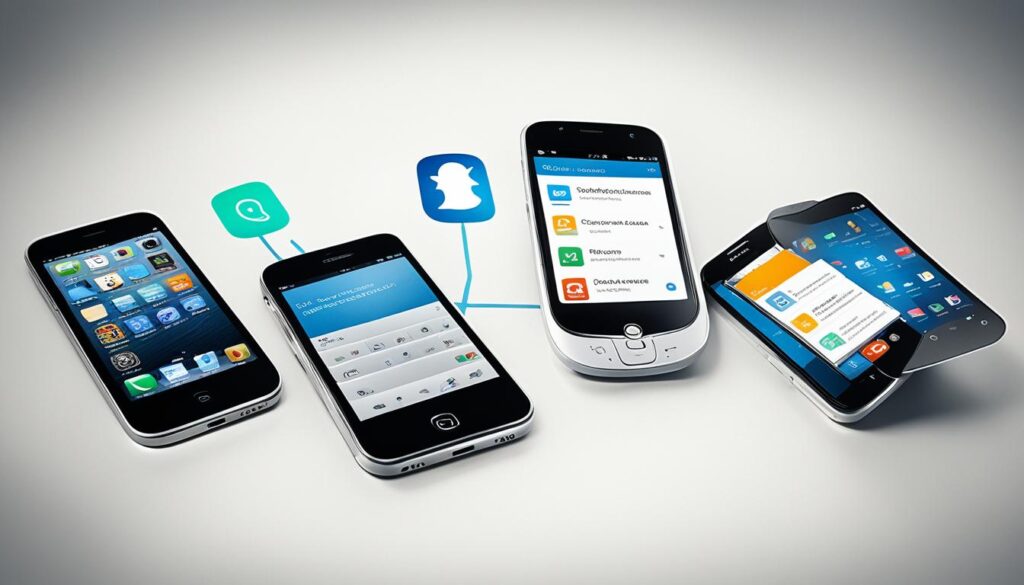
In this section, we will delve deeper into the mainstream smartphone operating systems, namely iOS, Android, and Windows. We will discuss the unique features, user experience, and app ecosystems of each operating system, providing insights into their strengths and weaknesses. By understanding the differences between these operating systems, readers can make informed decisions when choosing a smartphone.
When it comes to smartphone operating systems, three major players dominate the market: iOS, Android, and Windows. Each operating system offers a distinct user experience and caters to different needs and preferences. Let’s take a closer look at each of these operating systems:
iOS
iOS, developed by Apple, powers iPhones and is known for its intuitive interface and seamless integration with other Apple devices. The iOS ecosystem offers a curated selection of high-quality apps and a focus on privacy and security. Apple releases regular updates to improve performance and introduce new features. The latest version, iOS 15, introduced enhanced FaceTime capabilities, redesigned notifications, and improved multitasking.
Android
Android, developed by Google, is the most widely used smartphone operating system globally. It offers a customizable user interface and a vast array of apps from the Google Play Store. Android provides users with more flexibility in terms of device options across various price ranges, allowing for greater customization and personalization. The latest version, Android 12, introduced a new Material You design language, enhanced privacy features, and improved performance.
Windows
Windows, developed by Microsoft, offers a unique operating system for smartphones. While Windows smartphones are less prevalent in the market compared to iOS and Android devices, they provide a seamless integration with Windows PCs and other Microsoft services. Windows smartphones offer a familiar desktop-like interface and productivity features for users who heavily rely on Microsoft Office tools and services.
Each operating system has its own strengths and weaknesses, and the choice of a smartphone operating system ultimately depends on individual preferences and requirements. Whether you prioritize a seamless ecosystem, app availability, customization options, or integration with other devices, understanding the features and user experience offered by iOS, Android, and Windows will help you make an informed decision.
Understanding Smartphone Form Factors and Designs
Smartphones have evolved over the years, offering a wide range of form factors and designs to suit different user preferences. In this section, we will explore the various types of smartphone form factors and discuss the advantages and considerations of each design. Additionally, we will dive into the emerging trend of foldable phones and their potential impact on smartphone design.
One of the most common smartphone form factors is the candy bar design, which features a rectangular shape with a touchscreen display occupying the front of the device. This design maximizes screen real estate and provides a comfortable grip for users.
Another popular form factor is the slider design, which incorporates a sliding mechanism to reveal a physical keyboard or additional display. This design offers a combination of touchscreen and physical input options, catering to users who prefer a tactile typing experience.
Similarly, flip phones have seen a resurgence in popularity, especially among those who prioritize compactness and nostalgia. These phones feature a folding mechanism that allows the device to be folded in half, protecting the display and creating a smaller form factor when closed.
One of the most exciting developments in smartphone design is the emergence of foldable phones. These devices feature flexible displays that can be folded or unfolded, allowing for a larger screen experience without sacrificing portability. Foldable phones offer the convenience of a tablet-sized display that can be folded into a more pocket-friendly form.
To visually demonstrate the different smartphone form factors, take a look at the image below:
“Smartphones have come a long way in terms of design, offering various form factors to cater to individual preferences. From candy bar designs, sliders, and flip phones to the innovative concept of foldable phones, there is a smartphone design for everyone. Each design has its own advantages and considerations, allowing users to choose a device that suits their needs and style.”
As smartphones continue to evolve, it’s exciting to see how manufacturers will push the boundaries of design to offer even more unique and innovative form factors in the future.
High-End Smartphones: Features and Innovations
High-end smartphones are designed to offer the latest advancements and cutting-edge features, catering to tech enthusiasts and power users. These flagship phones from top brands push the boundaries of smartphone technology, providing users with a premium experience.
Premium Materials and Build Quality
One of the hallmarks of high-end smartphones is their premium materials and exceptional build quality. Manufacturers use materials like glass, metal, and ceramic to create a sleek and luxurious feel. These devices are built to withstand daily wear and tear, offering durability and longevity.
Advanced Camera Technologies
The camera has become one of the most important features for smartphone users. High-end smartphones incorporate advanced camera technologies to deliver stunning image quality and enhanced photography capabilities. Multiple lenses, larger sensors, and sophisticated image processing algorithms enable users to capture professional-grade photos and videos.
Breakthroughs in Processing Power and Speed
High-end smartphones are equipped with powerful processors and ample RAM, resulting in lightning-fast performance and seamless multitasking. These devices can handle resource-intensive tasks such as gaming, video editing, and running demanding applications with ease. With faster processing speeds, users can enjoy a smooth and responsive smartphone experience.
| Brand | Flagship Model | Standout Features |
|---|---|---|
| Apple | iPhone 12 Pro | Dolby Vision HDR recording, LiDAR scanner, A14 Bionic chip |
| Samsung | Galaxy S21 Ultra | 108MP camera, 100x Space Zoom, Exynos 2100 / Snapdragon 888 |
| Pixel 5 | Night Sight, Astrophotography mode, Stock Android experience |
High-end smartphones continue to push the boundaries of what’s possible in the mobile industry. From premium materials and exceptional build quality to advanced camera technologies and breakthroughs in processing power and speed, these devices offer an unmatched user experience. Whether you prioritize photography, gaming, or overall performance, high-end smartphones provide the features and innovations you seek.
Budget-Friendly Smartphones: Best Value for Money
Not everyone wants or needs a high-end smartphone, which is why budget-friendly options are important. When considering affordable smartphone models, there are key features that can ensure you get the best value for your money. In this section, we will explore these features and provide recommendations for the top budget smartphones available in the market.
Key Features in Affordable Models
Despite their lower price tags, budget-friendly smartphones can still offer impressive features. Here are some key factors to consider when searching for an affordable phone:
- Display Quality: Look for a budget smartphone with a bright and vibrant display. Opt for at least an HD resolution screen for a more immersive viewing experience.
- Camera Performance: Affordable phones can still capture decent photos. Seek out models with a higher megapixel count, advanced camera features, and good low-light performance.
- Battery Life: Find a budget smartphone with a long-lasting battery that can keep up with your daily usage without requiring frequent recharging.
- Performance: Look for a smartphone with a capable processor and sufficient RAM to handle everyday tasks smoothly.
- Storage Capacity: Choose a budget-friendly phone with ample internal storage or expandable storage options to accommodate your apps, photos, and videos.
Top Budget Smartphones in the Market
Now that we’ve discussed the key features to consider, here are our recommendations for the top budget smartphones available in the market:
| Brand | Model | Price Range |
|---|---|---|
| Samsung | Galaxy A51 | $250 – $300 |
| Xiaomi | Redmi Note 9 | $200 – $250 |
| Motorola | Moto G Power | $200 – $250 |
| Pixel 4a | $350 – $400 | |
| OnePlus | Nord N10 5G | $300 – $350 |
These smartphones offer excellent value for money, providing a great balance between performance, features, and affordability. With careful consideration of the features you need and your budget, you can find a budget-friendly smartphone that meets your requirements.
The Role of Camera Quality in Smartphone Selection
Camera quality has become a crucial factor for many smartphone users. With the increasing popularity of smartphone photography and the rise of social media platforms, people are relying on their smartphones to capture and share high-quality images.
Advancements in camera technologies have transformed smartphone photography, allowing users to capture stunning photos with their devices. The quality of a smartphone’s camera is determined by various factors, including the number of lenses, the resolution of the image sensor, and the advanced image processing capabilities.
Smartphones with multiple lenses, such as wide-angle, telephoto, and macro lenses, provide users with the versatility to capture different types of shots. This allows individuals to experiment with different perspectives and create professional-looking photos.
High-resolution sensors play a vital role in producing sharp and detailed images. They allow smartphones to capture more light and provide better low-light performance. This is especially important for nighttime photography or indoor shots where lighting conditions may be challenging.
Furthermore, advanced image processing capabilities enhance the overall quality of smartphone photos. These capabilities include features like optical image stabilization, night mode, and artificial intelligence enhancements, which optimize settings and improve image clarity.
When choosing a smartphone, it is essential to consider the camera quality and features that meet your photography needs. Whether you’re a professional photographer or an enthusiast looking to capture memorable moments, a smartphone with excellent camera capabilities can significantly enhance your photography experience.
Different Types of Smartphones and Their Target Audiences
Different types of smartphones cater to specific target audiences with varying needs and preferences. In this section, we will explore smartphones designed for tech-savvy users who seek the latest features and innovations. We will also discuss smartphones tailored for business professionals, including productivity features and security measures. Finally, we will provide considerations for elderly smartphone users, focusing on user-friendly interfaces and accessibility features.
Smartphones for the Tech-Savvy User
For tech-savvy users who crave cutting-edge technology and advanced features, there are smartphones that deliver exceptional performance and innovation. These smartphones often come equipped with high-resolution displays, powerful processors, and state-of-the-art camera systems. Additionally, they may offer features like augmented reality capabilities, facial recognition, and 5G connectivity. Tech-savvy users value the latest advancements in smartphone technology and seek devices that push the boundaries of what is possible.
The Ideal Devices for Business Professionals
Business professionals rely heavily on smartphones to stay productive and connected on the go. These smartphones are designed with business-oriented features to enhance efficiency and security. They often include advanced email and calendar management, secure messaging apps, and powerful productivity tools. Business professionals can also benefit from smartphones that offer seamless integration with their workplace software and remote access capabilities, ensuring they can work effectively from anywhere.
What to Consider for Elderly Users
When selecting a smartphone for elderly users, it’s essential to consider their specific needs and limitations. Elderly users typically prefer devices with user-friendly interfaces, larger buttons, and clear display fonts. Smartphones with accessibility features like voice assistants, magnification options, and hearing aid compatibility are also beneficial. The ease of use, simplicity, and reliability of a smartphone are crucial factors for elderly users who may be less familiar with technology. Manufacturers are increasingly focusing on creating devices that cater to the needs of this demographic by making smartphones more intuitive and accessible.
Smartphones with the Best Battery Life
Battery life is a crucial factor for many smartphone users, especially those who rely heavily on their devices throughout the day. To help you find a smartphone that can keep up with your needs, we have compiled a list of models known for their long-lasting performance and efficient power consumption.
When it comes to battery life, several factors contribute to extended usage time. One key factor is battery capacity, which determines the amount of charge a smartphone can hold. Devices with higher battery capacities generally offer longer battery life. Additionally, software optimization plays a significant role in maximizing battery efficiency. Smartphones with well-optimized operating systems and power-saving features tend to have better battery performance.
Fast charging capabilities are also worth considering. Smartphones that support fast charging can quickly recharge their batteries, allowing you to get back to using your device in no time.
Here are some smartphones that are renowned for their exceptional battery life:
“The Asus ROG Phone 8 Pro smartphone offers incredible battery life, lasting up to 18:48 hours on a single charge. With its 5,500 mAh battery capacity and advanced software optimizations, you can confidently use your smartphone throughout the day without worrying about running out of power.”
- Asus ROG Phone 8 Pro – [5,500 mAh battery capacity |18:48 hours of battery life]
- OnePlus 12R – [2,750mAh battery capacity | 18:42 hours of battery life]
- Asus ROG Phone 7 Ultimate – [2,750mAhbattery capacity | 18:32 hours of battery life]
- OnePlus 12 – [2700mAh battery capacity | 17:41 hours of battery life]
- Samsung Galaxy S24 Ultra – [4755mAh battery capacity | 16:45 hours of battery life]
- Samsung Galaxy S24 Plus – [4,900mAh battery capacity | 16:32 hours of battery life]
- Motorola Edge Plus – [5,100-mAh battery capacity | 15:47 hours of battery life]
- iPhone 15 Plus – [4,407 mAh battery capacity | 14:14 hours of battery life] (tie)
- RedMagic 8 Pro – [6,000 mAh battery capacity | 14:14 hours of battery life] (tie)
- iPhone 15 Pro Max – [ 4,441 mAh battery capacity | 14:02 hours of battery life]
- iPhone 14 Pro Max – [4323 mAh battery capacity | 13:39 hours of battery life]
- Samsung Galaxy S24 – [4,000-mAh battery capacity | 13:28 hours of battery life]
- OnePlus Nord N300 – [4,000-mAh battery capacity | 13:13 hours of battery life] (tie)
- Asus Zenfone 9 – [5000mAh battery capacity | 13:13 hours of battery life] (tie)
- OnePlus 11 – [5000mAh battery capacity | 13:10 hours of battery life]
These smartphones offer impressive battery life, ensuring that you can stay connected and productive throughout the day without constantly worrying about finding a charging point. Whether you’re a frequent traveler or a heavy smartphone user, these devices are designed to keep up with your demanding lifestyle.
Sustainability and Eco-Friendly Smartphones
With the growing concern for environmental sustainability, more and more people are seeking eco-friendly options in their everyday lives, including their smartphones. In this section, we will explore the concept of sustainable smartphones and highlight brands that are taking steps towards reducing electronic waste and prioritizing the use of recycled materials.
Smartphones with Replaceable Parts
One key aspect of sustainable smartphones is the ability to replace parts instead of discarding the whole device. By offering replaceable parts, manufacturers can extend the lifespan of smartphones and reduce electronic waste. This not only benefits the environment but also provides cost-effective solutions for users.
Several smartphone brands have recognized the importance of this approach and have started incorporating modular designs that allow users to easily replace components such as batteries, screens, or cameras. By making it simpler to repair and upgrade smartphones, these brands are supporting sustainability efforts and empowering users to make conscious choices.
Brands Focusing on Sustainability
In addition to modular designs, many smartphone manufacturers are actively working towards sustainability in their manufacturing processes. These brands are embracing eco-friendly practices, such as using recycled materials and reducing their carbon footprint by sourcing renewable energy.
Google, for example, has made sustainability a priority in their smartphones, including the Google Pixel series. They have committed to using recycled materials throughout their devices, including the use of recycled aluminum for the phone’s casing. This not only helps reduce waste but also minimizes the environmental impact of raw material extraction.
Other brands like Fairphone are taking sustainability a step further by prioritizing ethical sourcing of materials and ensuring fair labor practices. They aim to create smartphones that are not only environmentally friendly but also socially responsible.
By choosing smartphones from these brands, consumers can support sustainability efforts and contribute to a greener future.









